


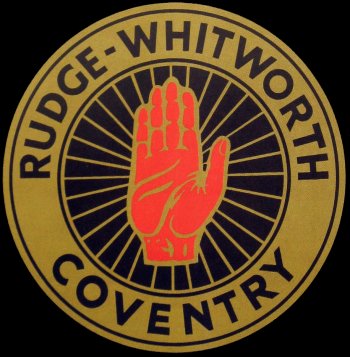

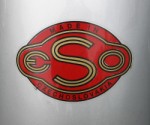

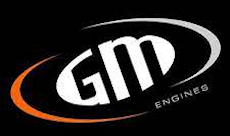
Bikes Page 1
Bikes Page 2
Bikes Page 3 Bikes Page 4 Bikes
Page 5 Bikes Page 6
Bikes Page 7
Bikes Page 8
I have pulled together a few items from the sports beginning to the present day (see below)
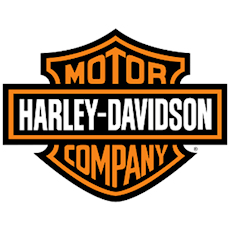
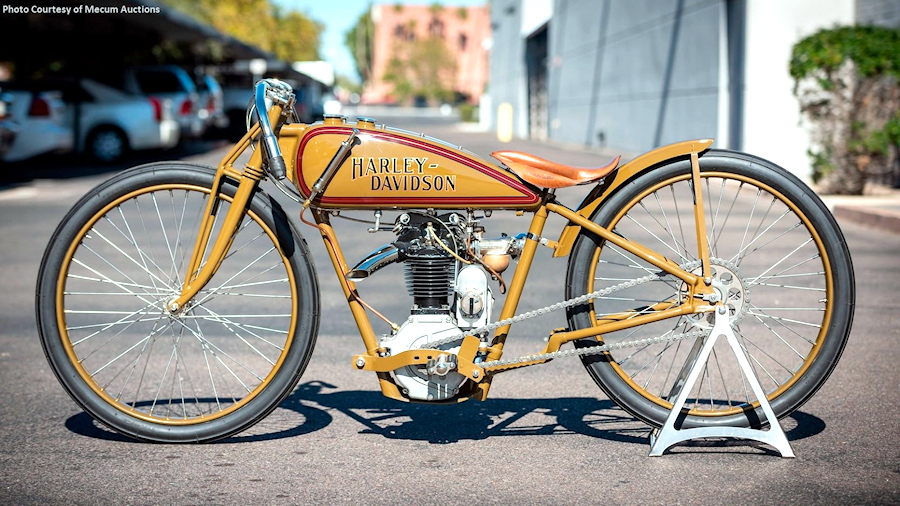
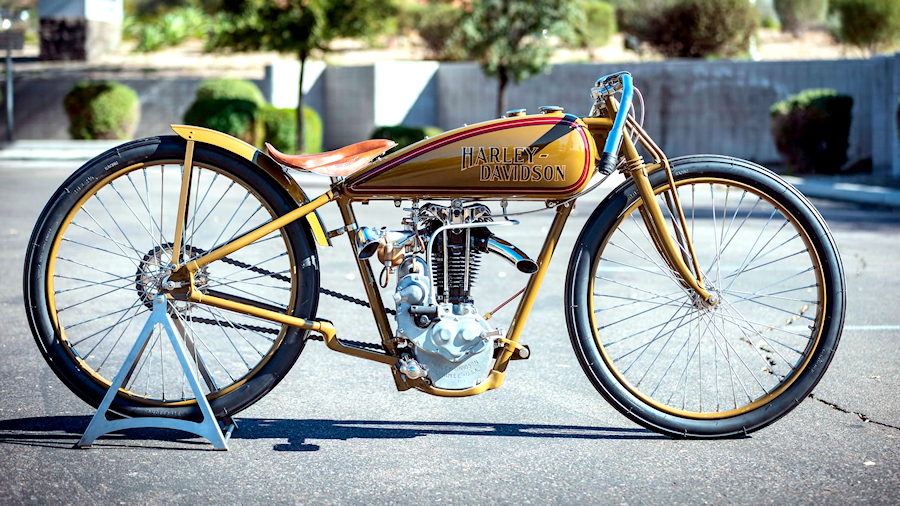

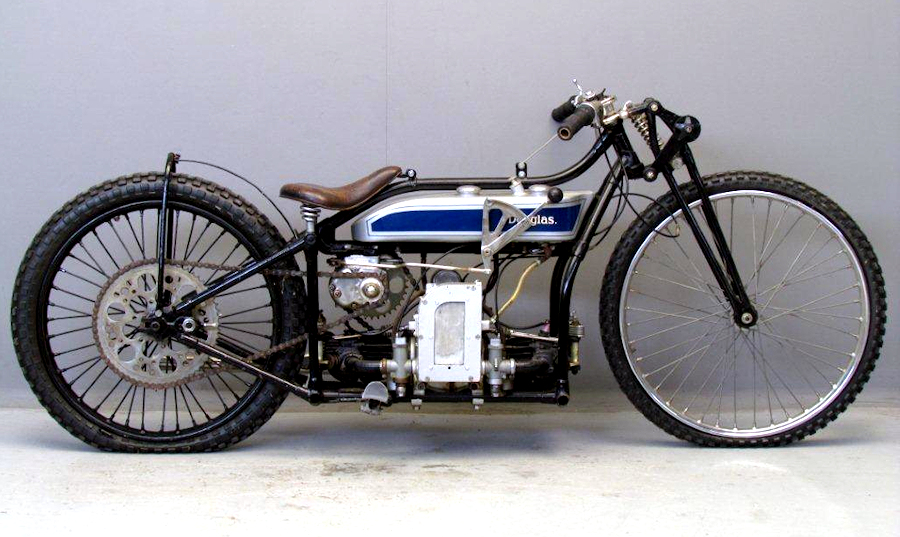
Courtesy of Yesterdays Antique Motorcycles
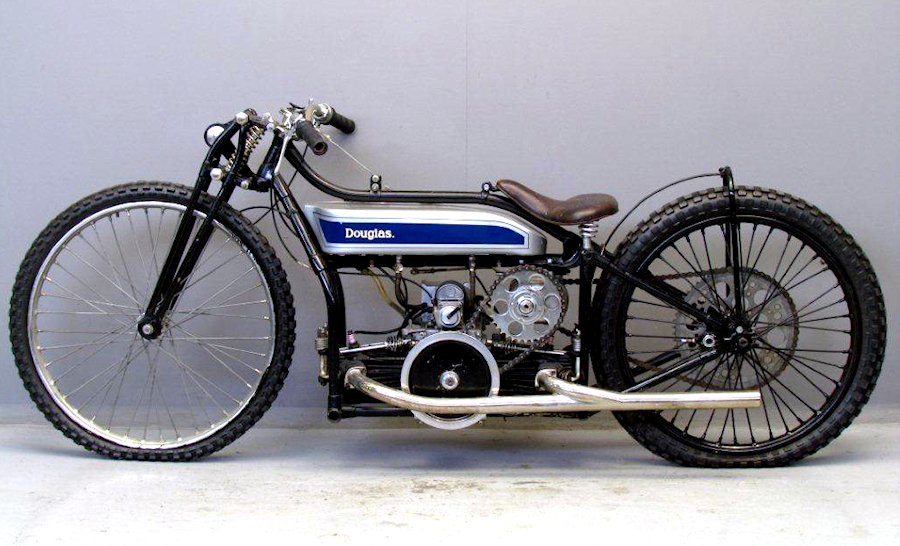
Courtesy of Yesterdays Antique Motorcycles
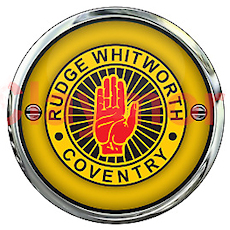
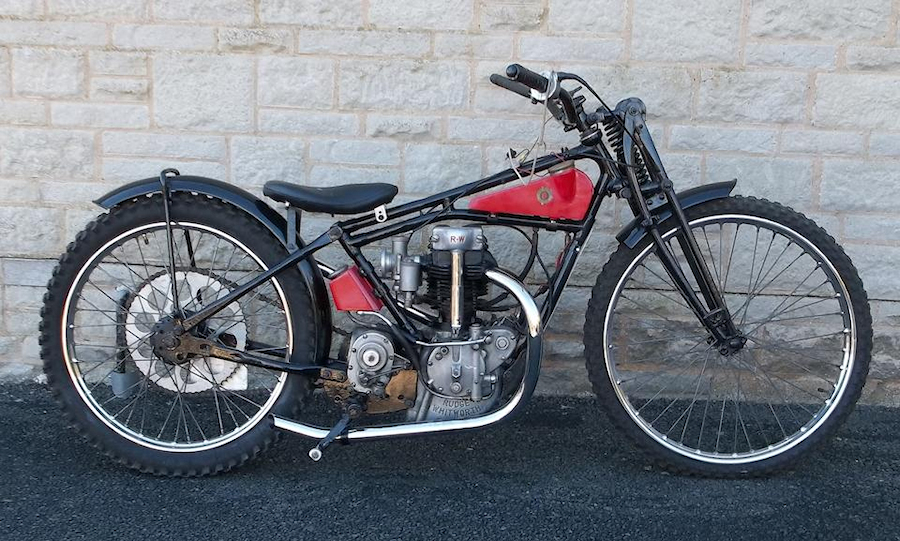
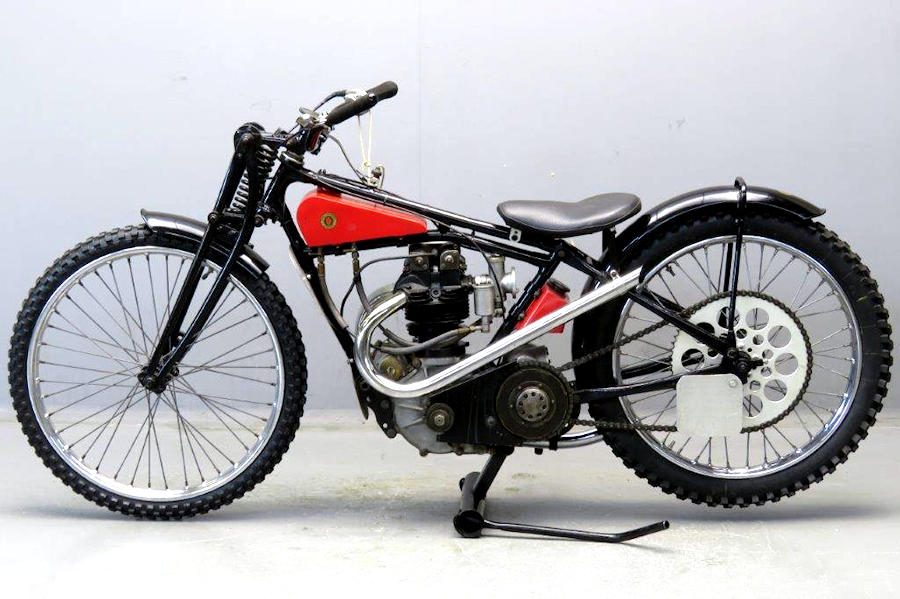
Rudge 1930 Speedway 500cc 1 cyl ohv 2607
Dirt
track (speedway) racing arrived in the UK in 1928 from Australia, the
first make of motorcycle to achieve dominance on the cinders being
Douglas.
The latter was soon deposed and for a while it was the
lighter and more compact Rudge that ruled the roost, before the arrival
of the ubiquitous 'Speedway JAP' set the pattern for the next 30 years.
Equipped with the 1927 works-type engine, Rudge's first 4-valve speedway
prototype was assembled in June 1928 and the model entered production
the following month; at first the frame was fitted with bracing struts
to prevent flex, though these would soon be abandoned. Once the JAP
engine had established its superiority, production of the Rudge speedway
model ceased (in 1933), though they continued in use for a number of
years, sometimes fitted with JAP engines.
We found this 4-valve Rudge
speedway to run very well after a change of the large main jet ,
intended for alcohol, to a more suitable jet for regular fuel.
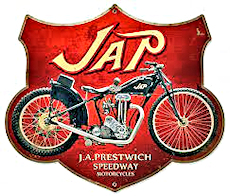
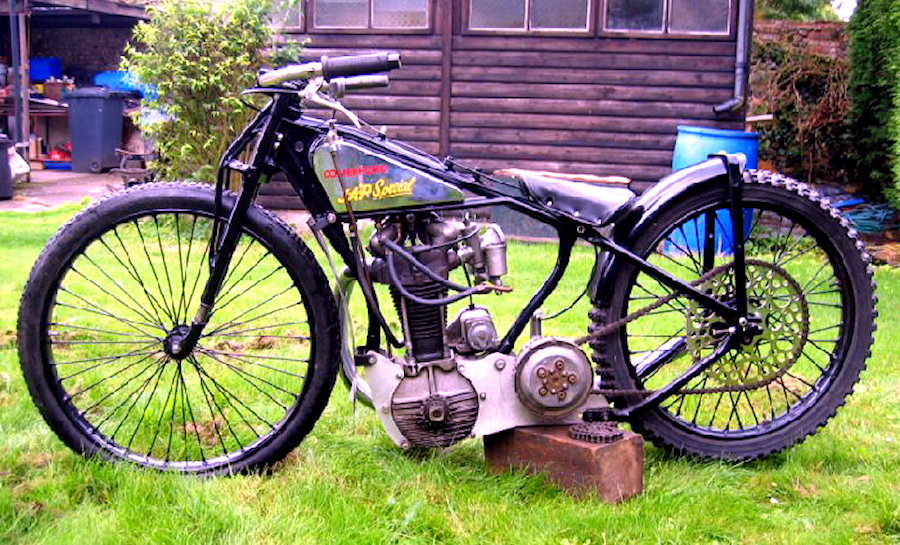
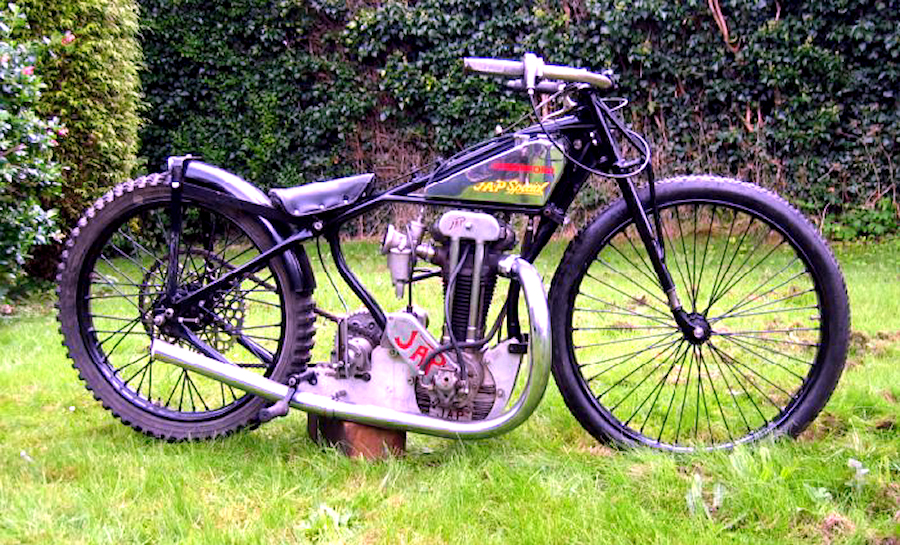
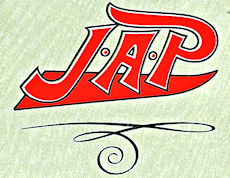
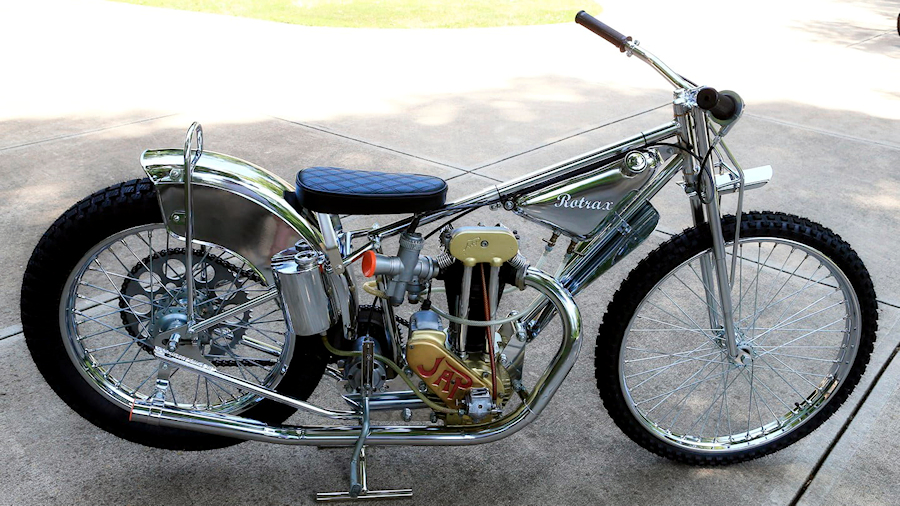
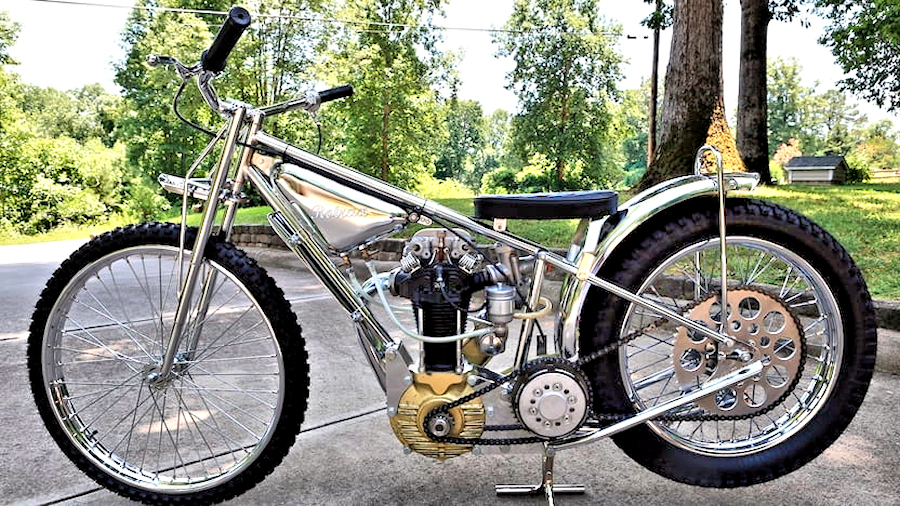
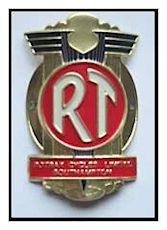
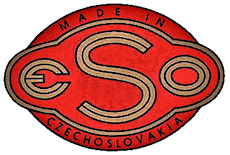
ESO translates into English as "ACE" As you can see from these photos the engine is a blatant copy of the British JAP. Josef Linhart made his bikes "The JOLI," between 1947 - 1950, the name being derived from the first two letters of his first name and his surname. The JOLI wasn't a financial success and in 1950, Jaroslav Simandl bought up all the remaining spares of the by now defunct JOLI engines and used them to produce his own version - the ESO. The JOLI engines were fitted with a Bronze cylinder head and used five holding down bolts, whilst the early ESO's came in three different cylinder head options. 1. With Bronze head and five holding bolts. 2. With Bronze head and four holding bolts. 3. With cast iron head and four holding bolts.
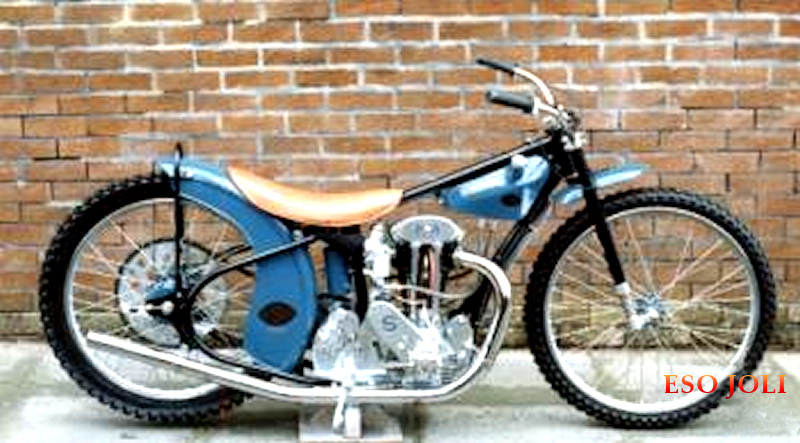
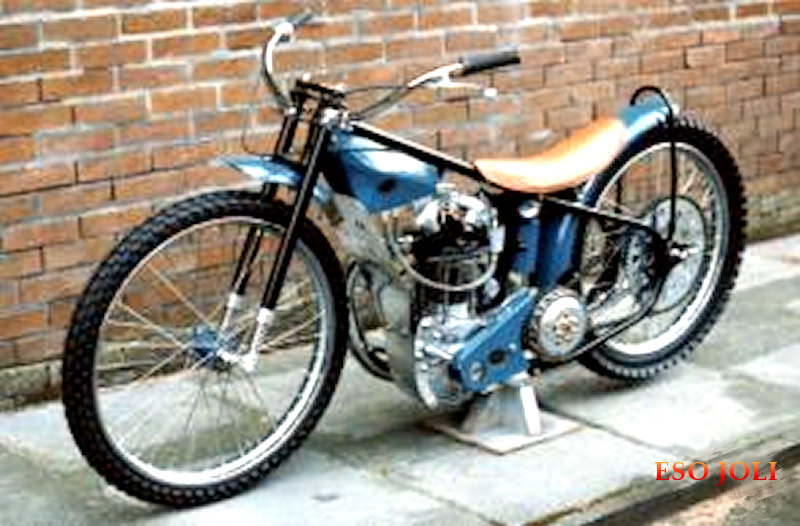

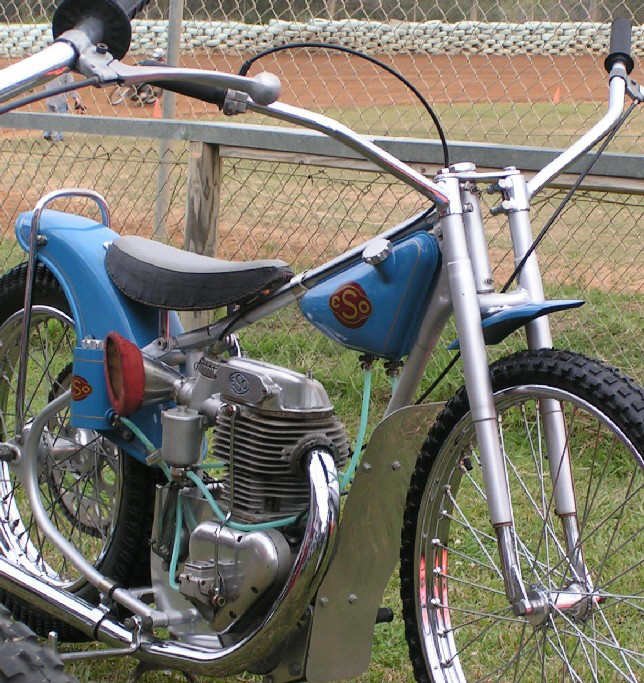
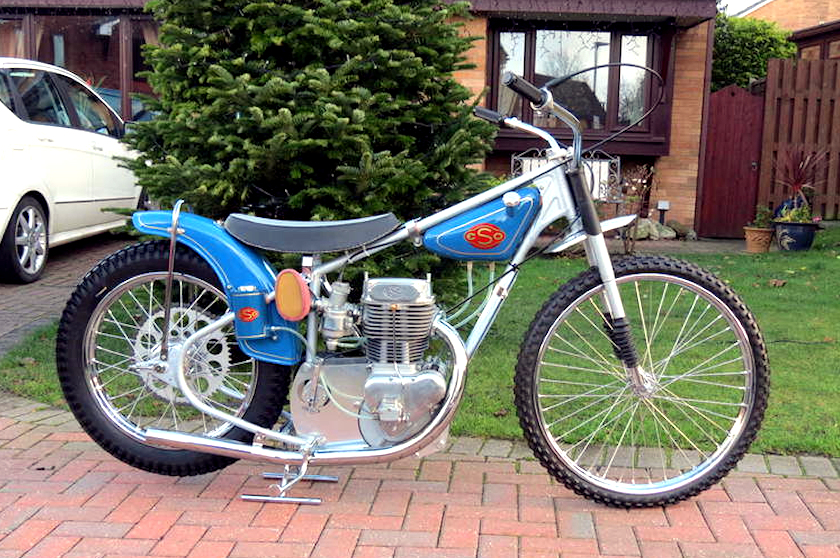
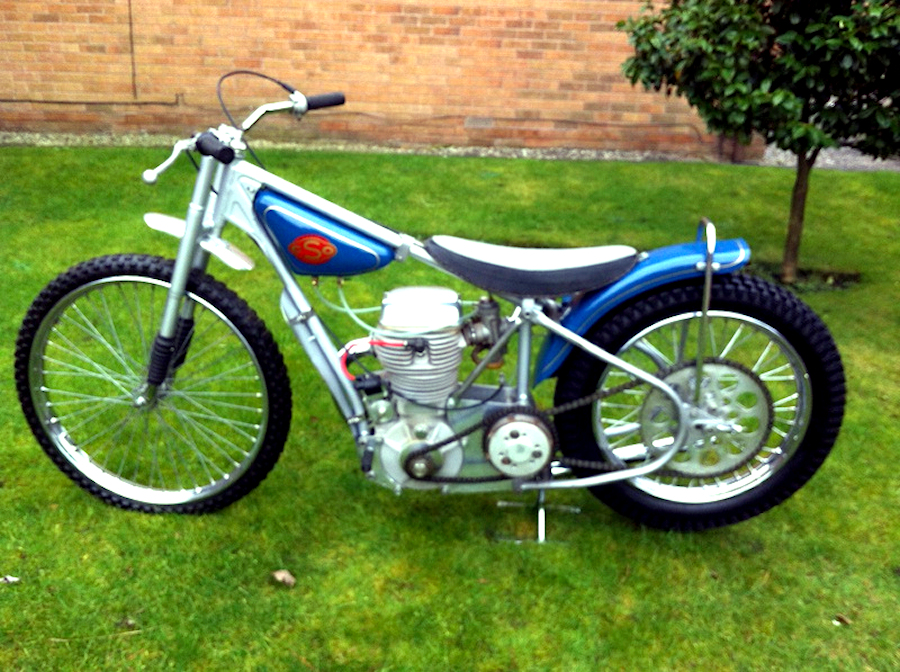
1962 ESO 2 Valve DT-6
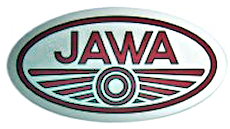
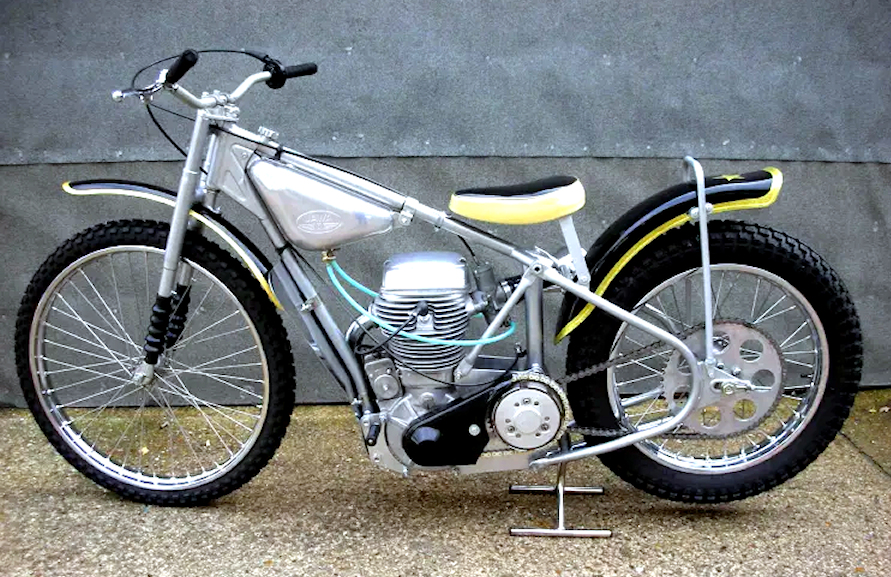
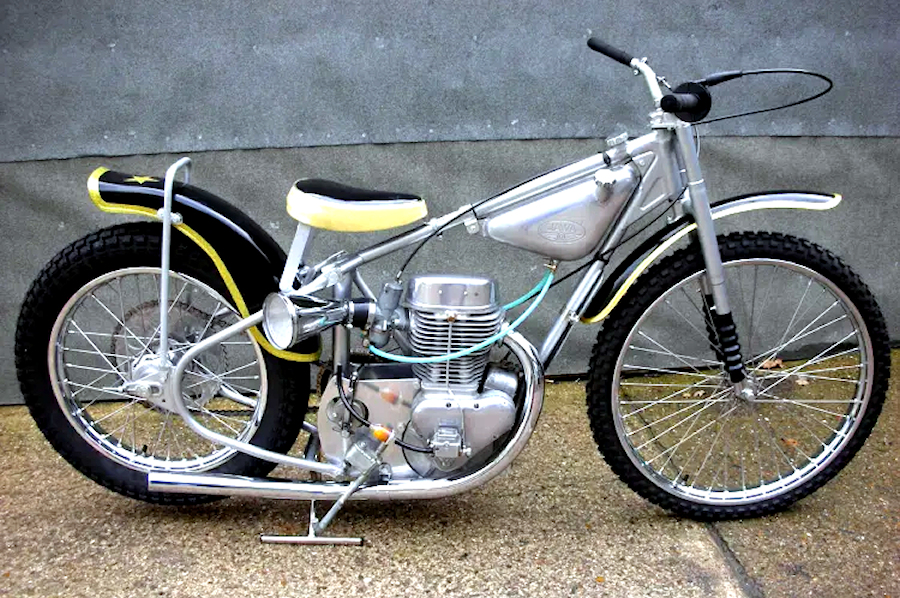

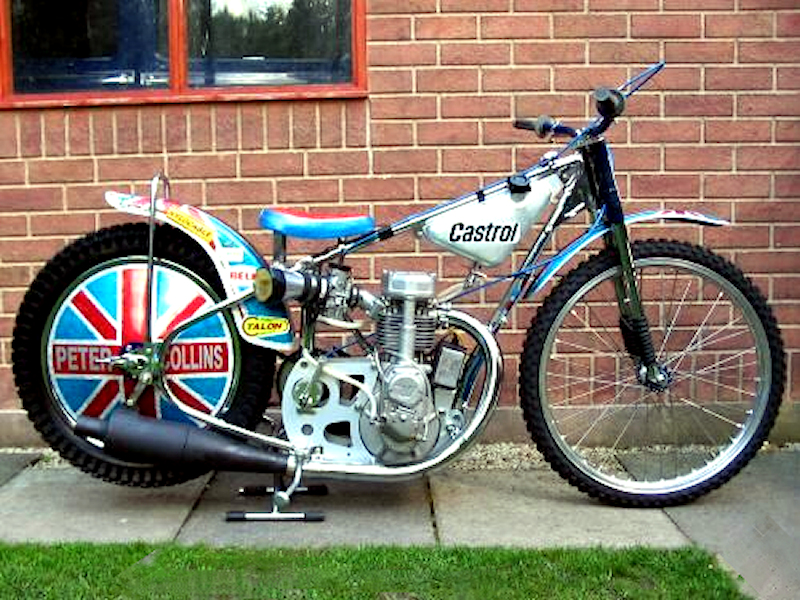
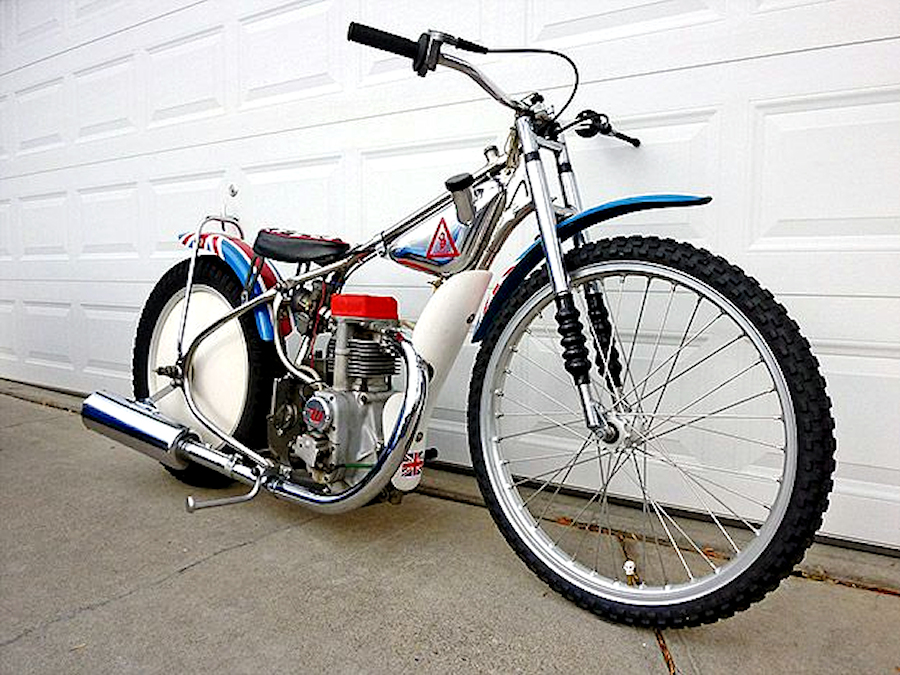
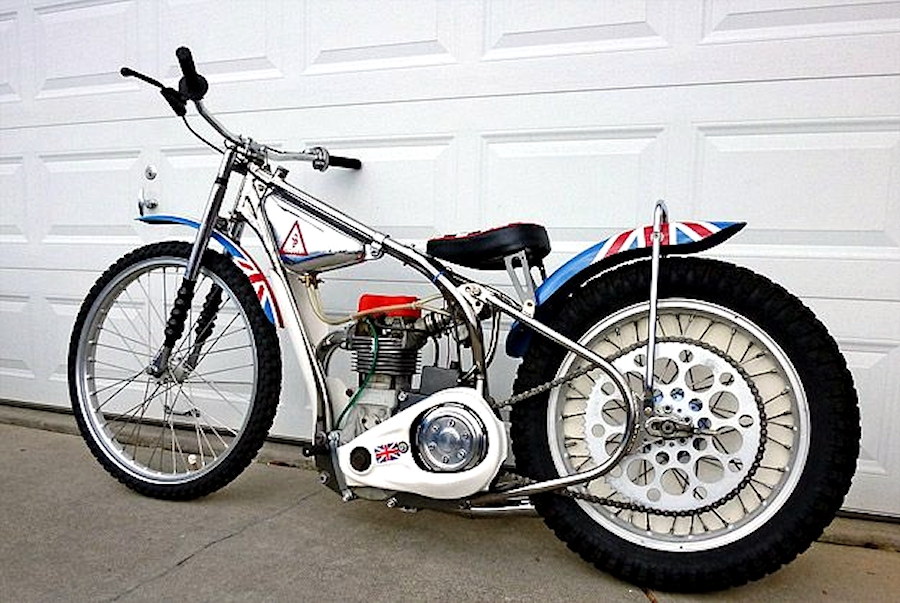
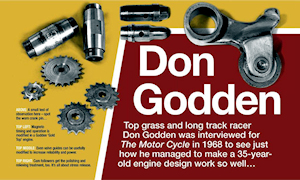
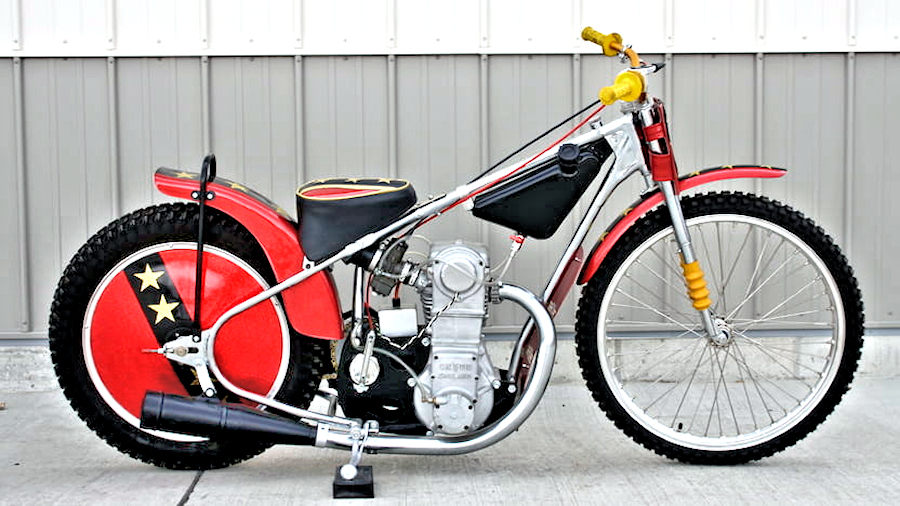
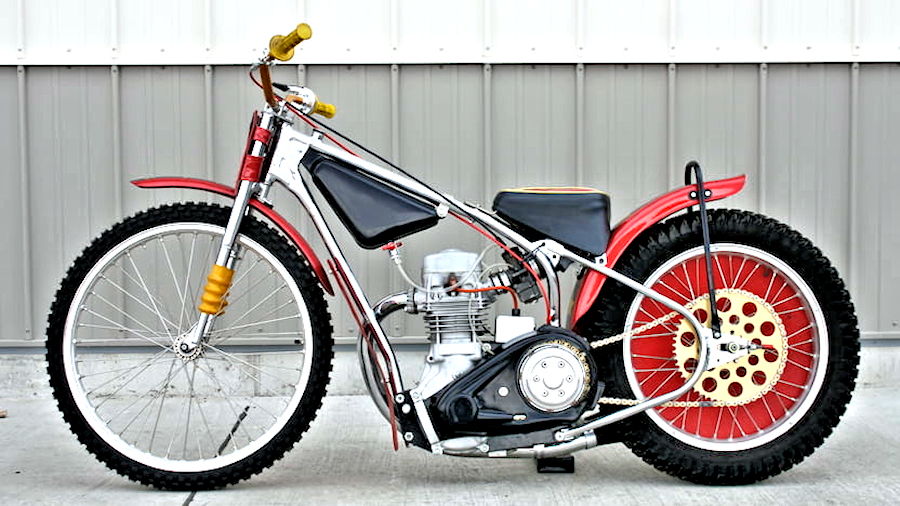
Godden Engineering is a small precision engineering company founded in the 1970's by former European Grasstrack Champion Don Godden. He initially start out by making speedway and grasstrack frames. Don quickly progressed into engine manufacture for speedway and grasstrack application and by the end of the 1970's the GR 500 was an established world class engine, soon to be followed by the Godden V-Twin.
To be able to keep up with demand for Godden engines, a very well equipped machine shop was established being able to produce high quality precision components. Don sadly died a few years ago
Godden Engineering is now owned by Gary Drake, who has 30 years of experience with the Goddens. Gary is keen to keep the machine shop up to date by investing in the latest CNC machinery.

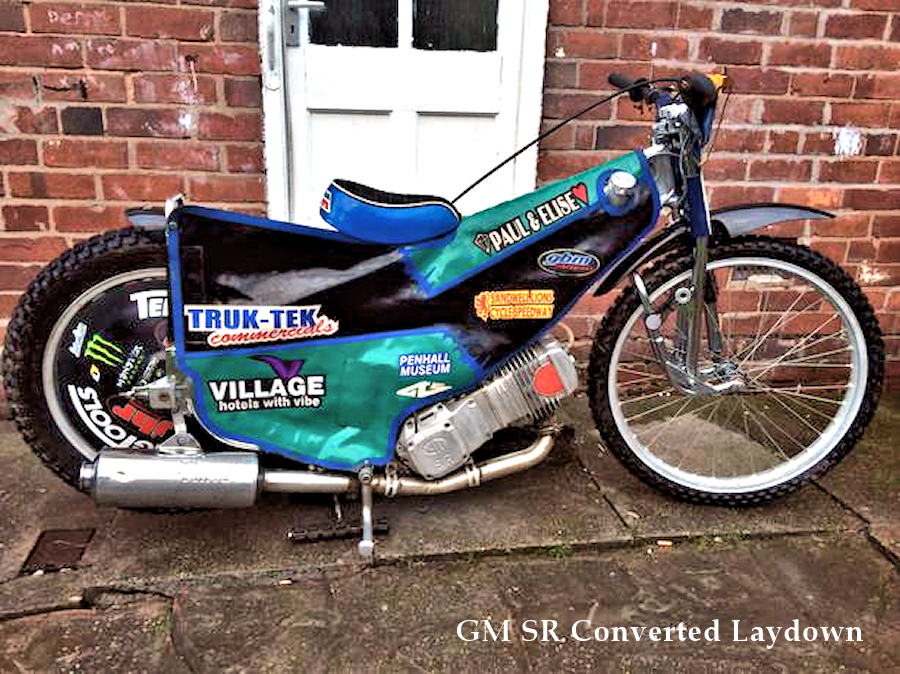
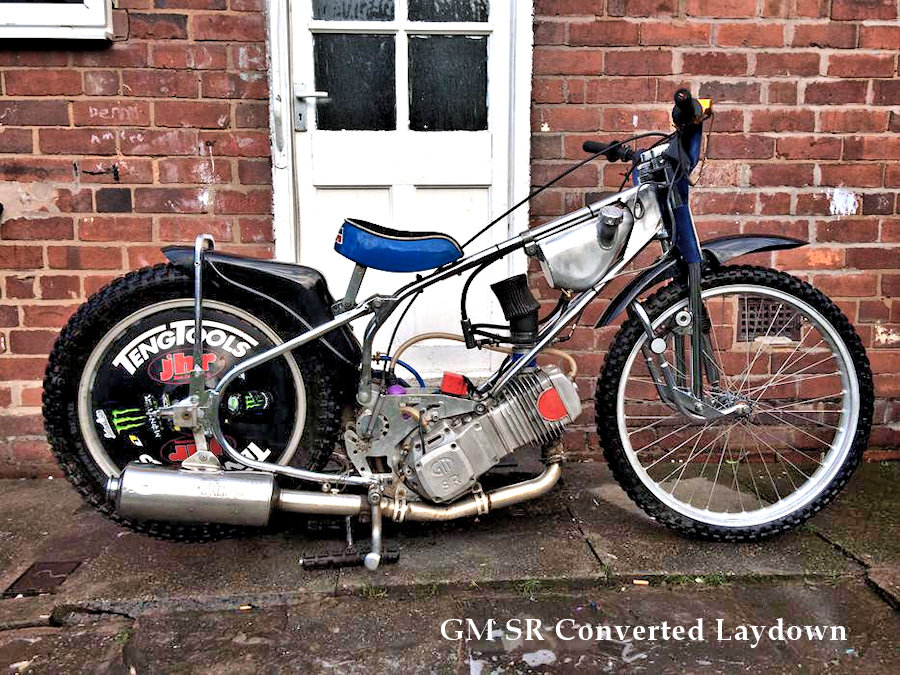
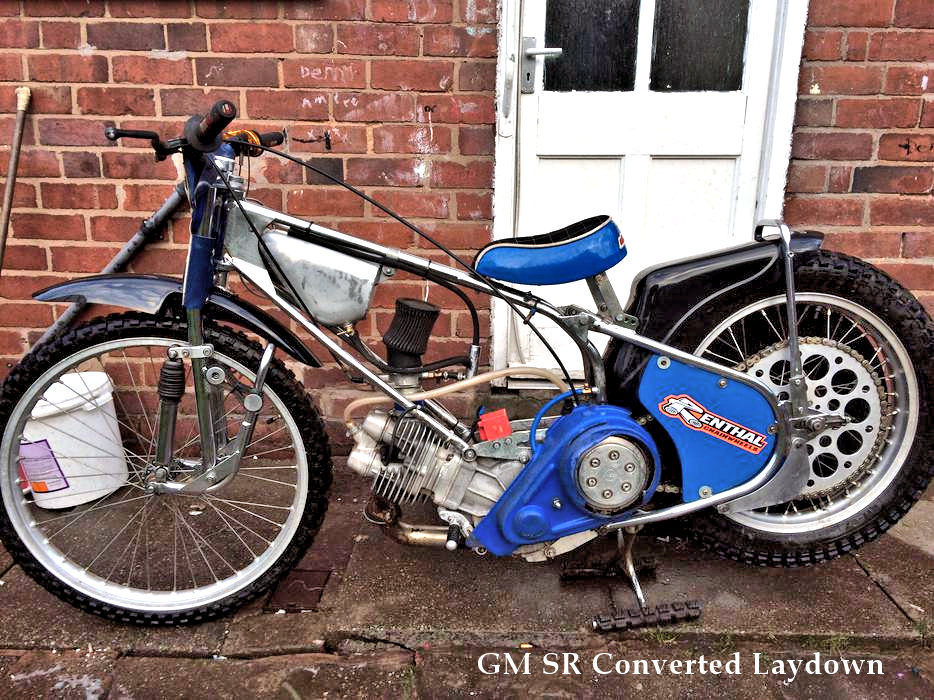
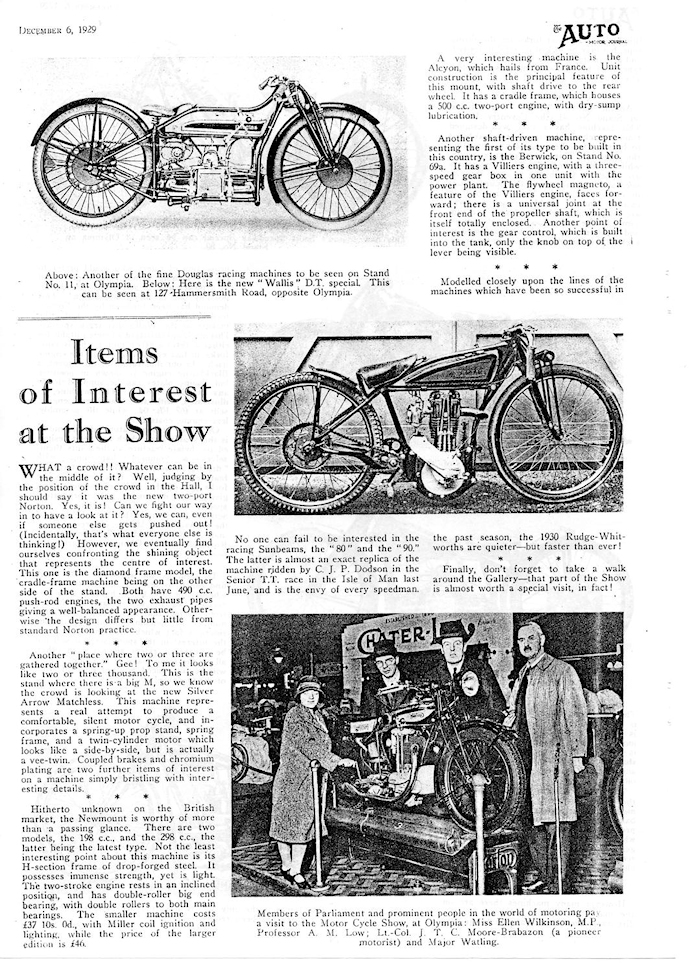
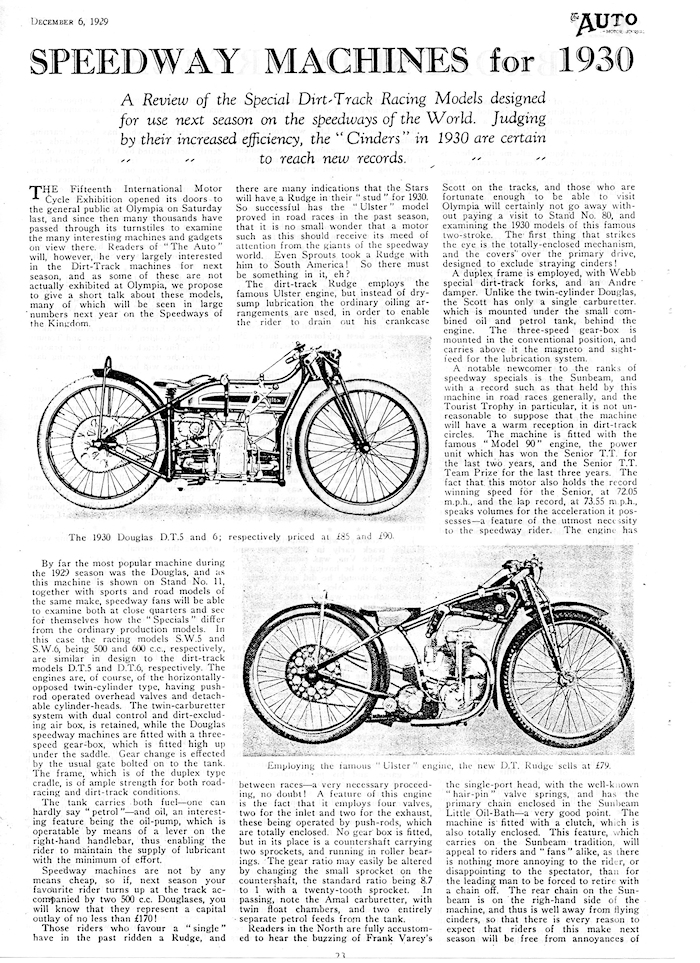
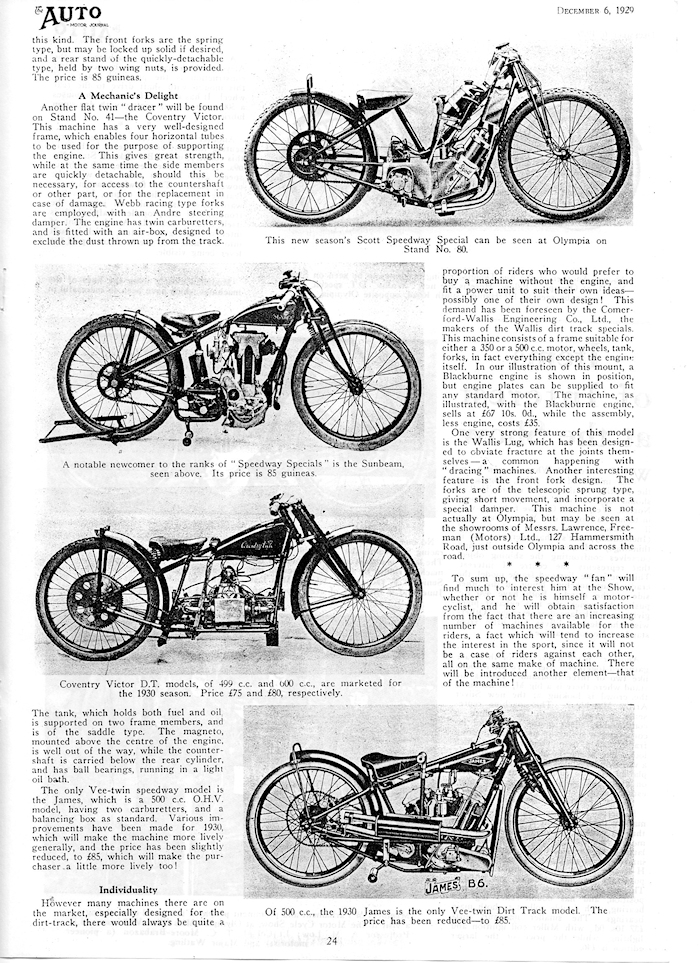
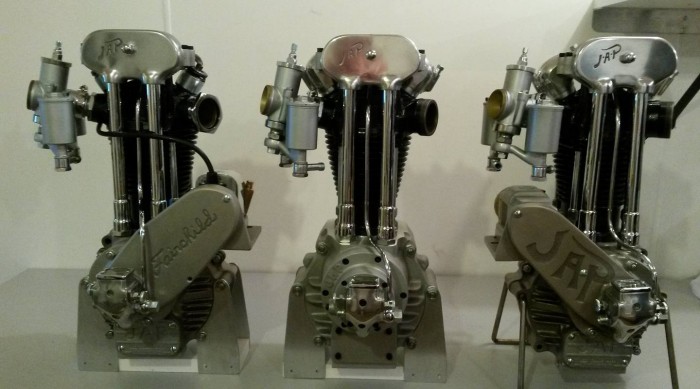
Giffy says: Hi John, I hope all is well with you. I have attached a picture, (see above) this one is for JAP lovers everywhere! The motor on the left is a Fairchild modification done by Jerry Fairchild in Los Angeles in the 1940’s, the idea was to prevent fuel from the carb getting into the magneto. Jerry made crankcases as well but I only have the mag platform on JAP cases. The motor in the centre is a Thornton JAP made in Auckland NZ by John Thornton in the mid sixties, He made cases and a mag platform at first and then came up with this coil ignition set up. I know of two others still in existence. The motor on the right is a common old four studder which is to go into a Rotrax frame. Viewers will notice that there are no air cleaners fitted, this is because I don’t have any! I can get the original gauzes and circlips for the Amal Type 27 carbs but not the original Amal intake Bell Mouth trumpets. If anyone could help with this I can be contacted at giffords@clear.net.nz. Bit cheeky John, I hope you will forgive me just this once. All the very best, giffy
Pre Speedway
Early-English
Track
Racing
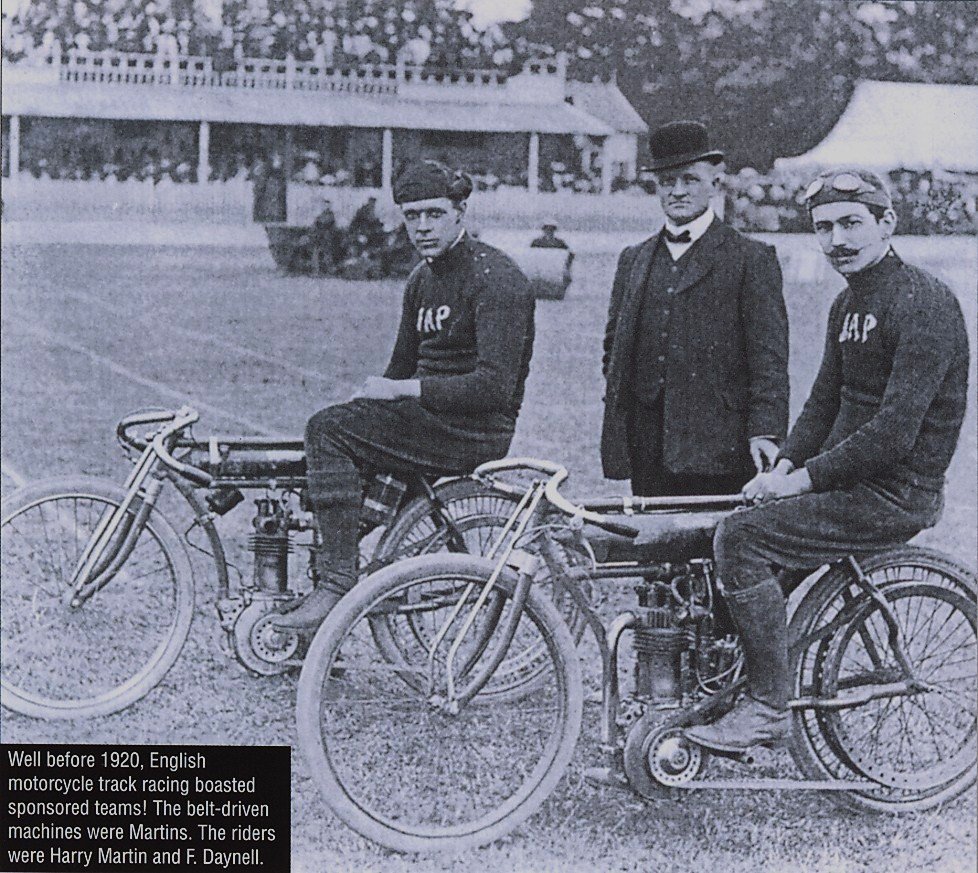
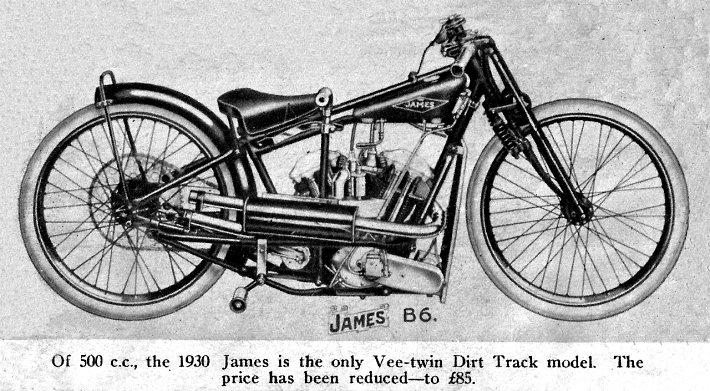
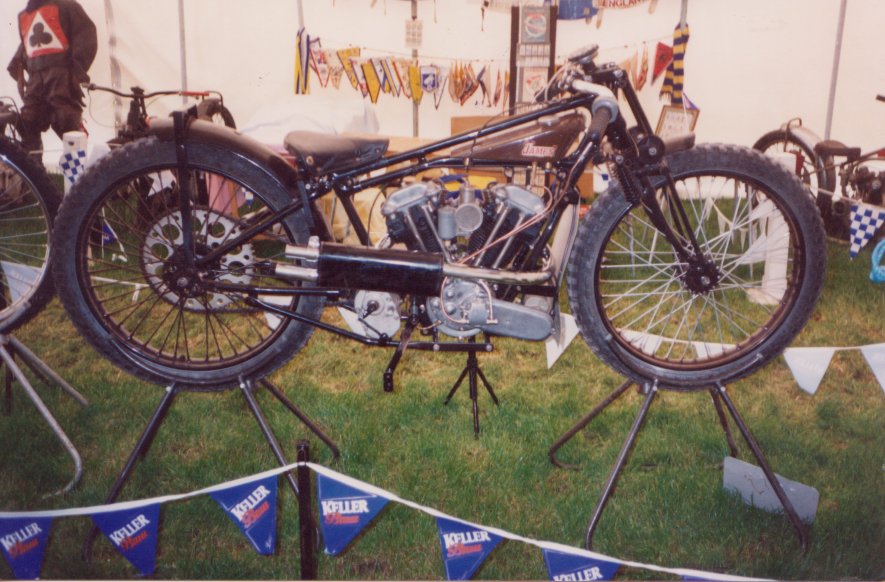

I believe this is a Crocker from the USA. The picture must date from the early 1930s as I think the factory started production of speedway bikes then. The manufacturer did not produce many bikes so they are collectors items now
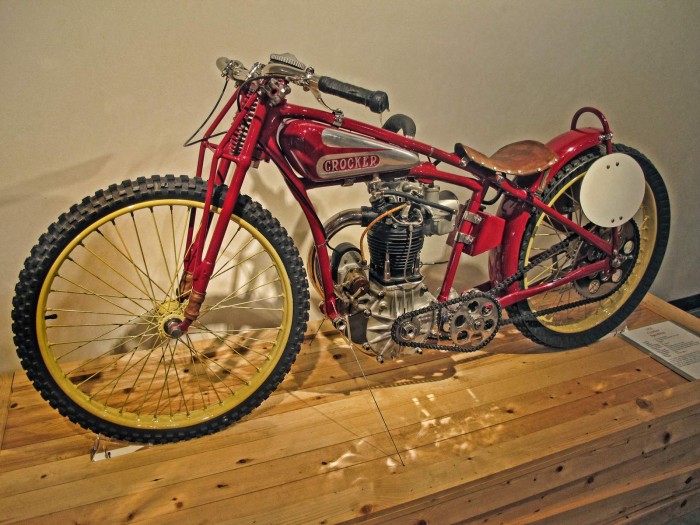
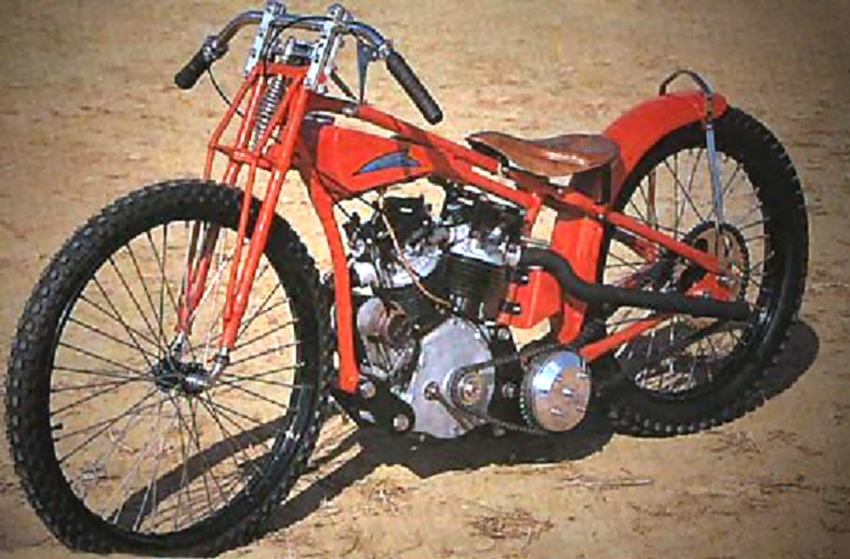
Looking at the Red "Crocker" OHV on your site, it's a fake by Gwen
Banquer. Crocker never used Rudge frames or 45 OHV.
The 1931
Crocker-Indian used Indian 45-inch side valve 2-7/8 x 3-1/2
The 1932
Crocker-Indian = Crocker frame and forks with Indian 101 Scout cases
with 2-1/2 x 3-1/16
= 30.50 OHV
1933 Crocker developed the 30.50 OHV single
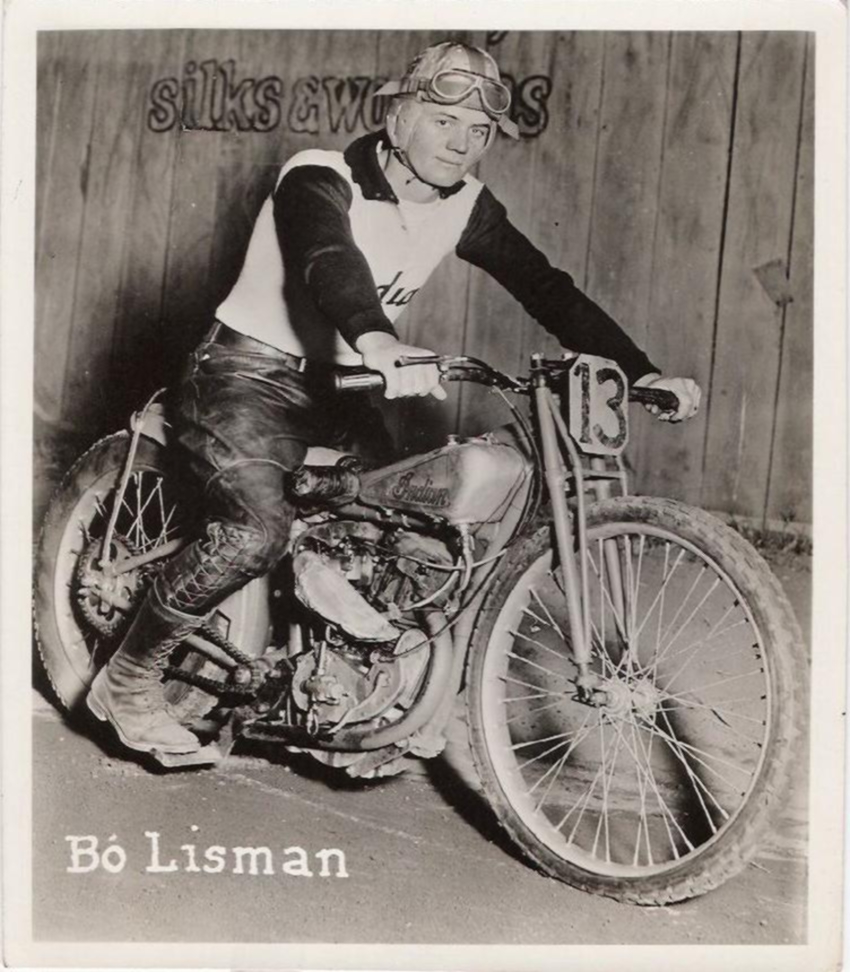
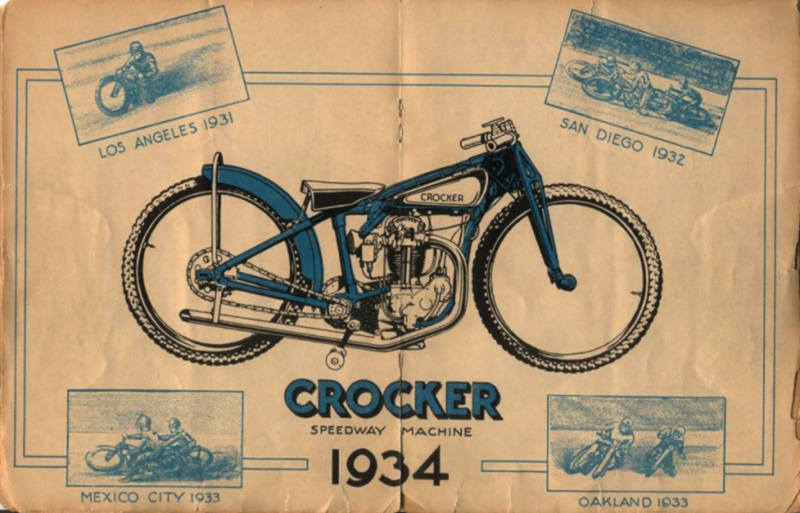
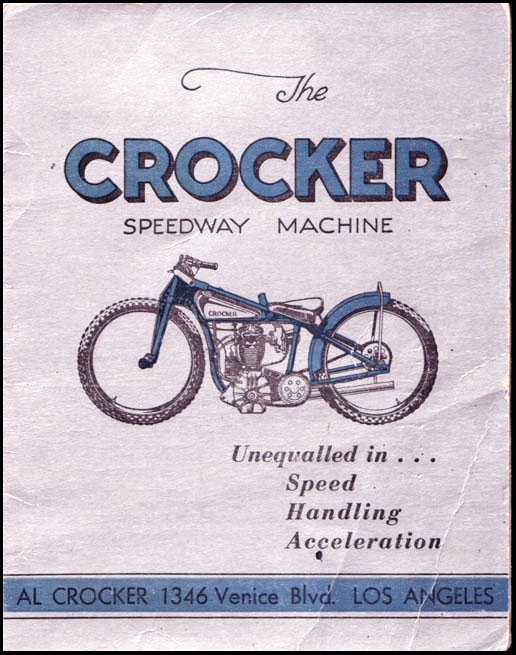
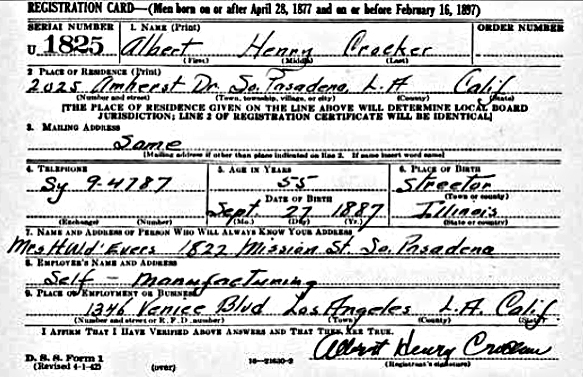
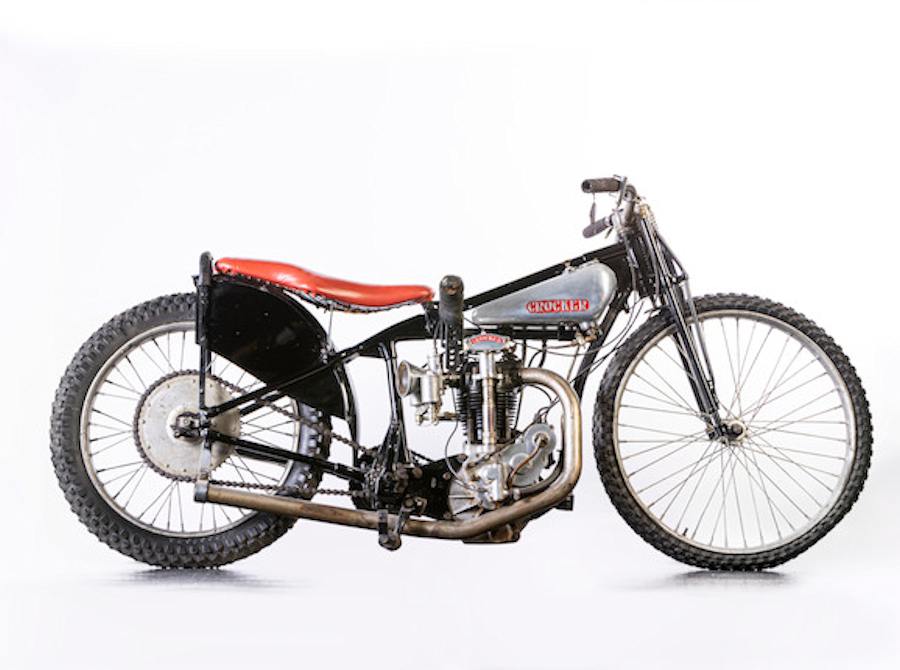

This 1926 AJS could be the worlds oldest surviving Dirt Track Bike. The bike was used in Australia in 1926 by Tony Batros, it has to be older than any British based bikes as our tracks didn't get under way until 1928. It is a 350cc AJS Special Racing GR7 Big Port. 350cc bikes were quite common on dirt tracks then, another 350cc was the Harley Peashooter.
-
Engine number G89173
-
Apparently Jack Brantom was a Leicestershire speedway rider. I’ve attached an article about it. I haven’t been able to verify any of it …. Except that the article definitely isn’t in the magazine issue referenced.
-
See above.
-
In terms of price, I got it in an auction for about 6k as a non-runner. Auctions are a bit funny at the moment and much of it going below reserve.
-
I’ve attached one photo.
By the way, I have a 1927 AJS H8 hill climb racer that I have just got going for the first time today (bought it at auction in April). Sadly my email wont let me attach the video file of it to send to you
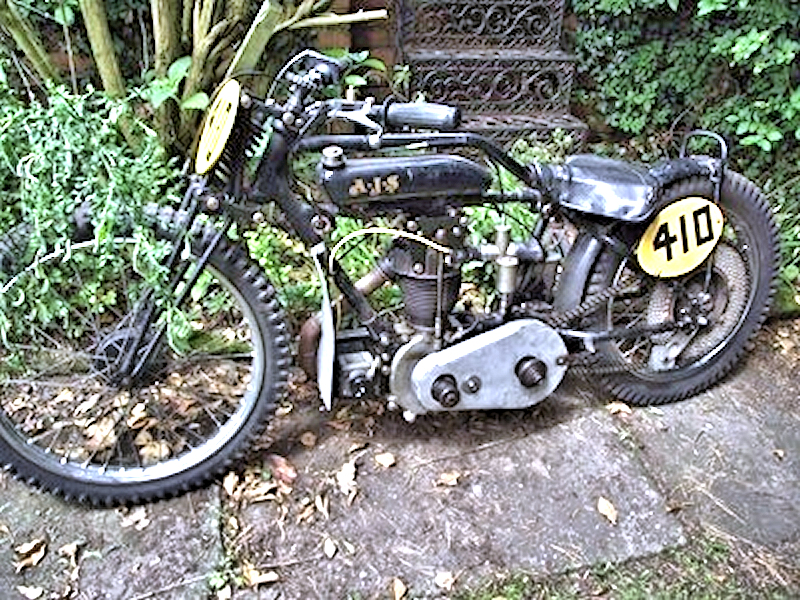
Bryan Lambert kindly
sent me this most interesting story that originated from an article in
the The Classic Motorcycle January 1988 and one that many, we are
sure, will find most intriguing. The original article was written by Celia
Walton, once VMCC grasstrack sidecar champion along with Barbara
Coombes and a long time member of the VMCC who used to race sidecar
grasstrack with her husband Simon - they are both now retired from
racing but still play a large part in running the section.
In 1934, Jack Brantom was looking for a bike to use for grass and dirt
track events. He searched for a while and then bought an ohv AJS engined
machine offered as a 1924 dirt tracker, although it was on the road at
the time.
It had a 1925 AJS frame, converted for grass track (the AJS factory
never produced any specific grass machines) indeed, the whole bike had
been altered for the sport. The original tank would have had a built-in
oil tank, hand pump and gear lever, but the person who converted the
Ajay had got rid of this in favour of the more usual tiny fuel tank.
Therefore, these components were missing, and a saddle tube mounted oil
tank had been made and a mechanical Best & Lloyd oil pump fitted (the
builder's personal choice against the AJS Pilgrim pump presumably). The
rocker plates were about the only place left to put the gear lever. The
magneto was not the usual make either, being an ML. There was a
three-inch bore flexible exhaust pipe with a genuine AJS aluminium
silencer. The engine was tilted forwards - no one knows why, but it
seemed to work all right so it was left in that position.
(Left) Mike Coombes looks apprehensive before venturing out on the AJS
"Killer".
Jack had owned two previous grass and dirt track machines,
both named "Killer". Before the war they were ridden on private tracks
near his home (with no transport available he simply pushed them along
the road to the track). An old lady in the village used to lean over her
gate whenever she saw this weird machine being pushed past. In her
cracked voice she'd cry "Ah, you'll get killed, you'll get killed""
Which, as you might have guessed by now is where the name derives. You
see, the first "Killer", a Rex Acme road racer, was stripped for
overhaul and needed painting. Jack found some beautiful royal blue
enamel - "my favourite colour" - so tank, frame, wheels and just about
everything else ended up royal blue. The two plated parts were polished
and all the half plated parts derusted and covered with aluminium paint.
A close friend, a signwriter, was most impressed and suggested Jack put
a name on it. This wasn't as simple as it sounds, as Malcolm Campbell
had already pinched "BlueBird". Then up came the standing joke. Giving
his best impression of the old lady, Jack croaked "Ah, you'll get
killed, you'll get killed!" "That's it!" said the signwriter, "Why not
Killer?", and so it was.
The next machine was an OK, and he put Killer II on that, so the ohv AJS
was naturally, Killer III. Jack himself made one or two alterations to
the bike. The magneto chaincase was removed to reduce weight and in 1937
he tried fuel injection, just the same as a carb without a float
chamber. His "unusual method of cornering" (his words) meant that all
his bikes had flat pipes and bent footrests, so the only answer for the
track was to take them off and use the pillion footrests. The AJS was
used with mixed success. At one point a new piston became essential, but
the Second World War was just beginning and new pistons were not
available for love, money or anything else. Jack had a sidevalve engine,
and in desperation used the cylinder and piston from this, bought some
methylated spirit from the chemists (with petrol on coupons during the
war there wasn't a lot of that about either) and rode it half a mile up
the road. The imbalance that the cast iron piston caused was
unbelievable. Back to the drawing board. About that time there was a
strong appeal for aluminium to build Spitfires, and Jack found himself
in the army. He reckoned that the more Spitfires, the sooner the war
would be over and the sooner he'd be ex-army, so the engine, gearbox and
aluminium silencer went to the good cause. What remained of the Killer
retired to the back of the shed.
With the war over, the bike languished under a sheet until Jack fell
over it while searching for something else. He looked at it and thought
it seemed a shame, somehow, to leave it there, and his son Dave was
enthusiastically riding in VMCC grass track events with a variety of
vintage and post vintage machines. So he started to look for the bits to
get it going once more. Bill Davies gave Jack a cylinder head for the
bike, and by pure chance it had Jack's "mark" on it. So much for the war
effort ! But did the rest survive? If anyone finds an AJS engine with a
sawn mag chaincase........... Jack was talking to the late Ormond Gurr
one day and the subject of spares came up. Ormond suggested joining the
VMCC, which he did and went to dozens of autojumbles. Even so, more of
the motor was manufactured than bought, so it's lucky that both father
and son are engineers. The flywheels are from a sidevalve, but
considerably lightened. The smaller pushrods and cases are all
home-made, though old bits were sometimes used for patterns -
occasionally slightly improved for weight and so on.
Ken Cobbing was able to supply beaded-edge tyres, as used pre-war, to
fit the home built wheels - rear with AJS hub, front of an unknown make.
The chain case came from a 500cc JAP, cylinder head, twist grip, rocker
return springs, taps and the magnet off the magneto are about all that
is original. The flexible exhaust pipe was rebuilt to pattern. It was
finished about 1973. It doesn't comply with modern rules and
regulations, when first built there weren't any rules or regulations to
comply with. The choice had to be made - rebuild as original, or go
along with modern rules - and Jack chose the former. The original used
pump petrol and straight grade oil, the present model started out
swimming in Castrol R but Jack subsequently found that the vegetable oil
becomes horribly gummy when left idle for months at a time and this was
changed to straight monograde of the mineral variety. Fuel? He quite
automatically mixed two parts of two-star with one-part paraffin and
added an eggcup of oil.
At the machine's first try-out, a VMCC hill climb, the rider was asked
to wear helmet, leathers and so on. The machine was not passed by the
scrutineer as it failed to meet present rules such as no ball ended
levers, snap-shut throttle or silencer. Latter impossible to fit anyway.
He couldn't get the bike going properly, even though he was given the
opportunity for a demonstration run after the event. It had carburation
problems and the engine tightened up at the slightest provocation.
(Above number 410)* The "Killer in all its glory.... including beaded
tyres !!
It was a bad day. A while later on Jack took the bike to a
local field and ran it all he could. He made three new jets, but "the
blighter still played up". Finally he took it out to Quainton mid-week
when it was deserted. He found a hard spot at the top of the hill to
bump it on and it fired first time but there were still obvious
carburation problems. Then, some months later, along came this woman who
was intrigued by the thought of a special made over 50 years ago lying
idle in a shed for all that time and then restored by the original
owner. It seemed a shame she thought, to let it vanish again, forgotten
without even getting going properly. So she cornered Jack and started
asking him questions about the bike's history and development - you've
just read the story. It seemed to me that the best way of finishing such
a tale would be a test ride. I am no solo rider, goodness knows,
especially on grass, but I did want to see what it felt like. So we took
it to a field where a VMCC hill climb was to be held. We didn't even try
to enter the event, Jack had fitted ball-end levers and a quicker
closing throttle, but it still had no mudguards or silencer and there
were a number of uncovered chains.
Perhaps fired by the desire of getting someone else to ride his machine
Jack had done a great deal of work on it. He had sorted out the
carburation for one thing, and it started pretty easily (leaving the
owner on his hands and knees on the grass at one point, as it started
more abruptly than expected). I brought it back for various adjustments
to be made, then rode off up the field desperately looking for the
footrests. I found them, in time to discover I needed to turn around and
then came the search for the brake! The beaded edged tyres were a bit
unnerving on slippery grass, and I couldn't get the hang of the hand
gear change at all, but there was no question acceleration was pretty
good. I asked Jack if someone more competent on a solo could have a
ride, and he agreed. So I fetched Mike Coombes, who successfully rides
all sorts and ages of vintage Grass track and speedway machines. His
first comments were that he didn't like the gear lever, or the position
of the footrests, or a number of little things. But he agreed it went
very well indeed, and handled nicely - he felt that with a weekend's
work altering the various details (all riders have their preferences for
position of handlebars etc) it would be a very competitive vintage grass
track machine indeed. So the "Killer" is alive again. I wonder how many
such specials, built long ago, are lying in sheds perhaps occasionally
robbed of spares by their owners either for use or sale? So many
machines were altered and improved in their past by riders for their own
use, they have a special place in the history of motorcycle sport. I'm
glad I'm one.
The Classic Motorcycle, January 1988.
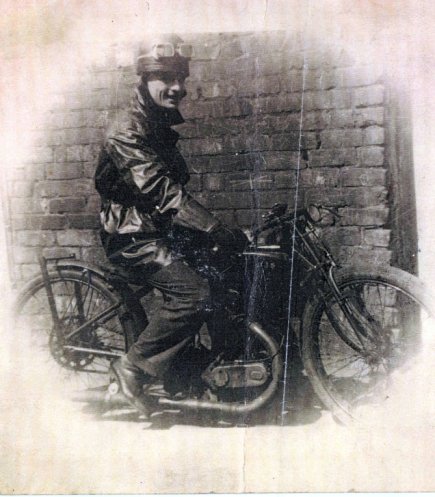
Dad used the AJ for work (Liverpool Gas Co ) he was a Plumber /Gas fitter. He fell off after winning Golden Helmet in about 1926 and got married 1927 Nearly turned pro I believe. Doc set his collar bone on the track and had a lumb there but lived to 82 d 1983
Jeremy Whittet says: Hi John,This may be of interest to you? I recently
bought a New Imperial grasstrack bike, for sale as part of a collection
of four bikes which used to belong to Jack Brantom, racer in the
twenties, and his son Dave. See link below to auction.
The four pre-war grass track bikes are
all part of the late Leicestershire grass tracker Jack Brantom and his
son Dave’s collection. Mark Bryan of H&H Classics comments: “It is rare
these days to find complete examples of grass trackers from the 1920s
and 1930s, so to find four from one collection with such an interesting
provenance is very satisfying.”
The bikes are:
-
c1928 OHV 500cc Douglas DT5 £13,000-£18,000
-
c1936 OHV 350cc New Imperial £4,000-£6000
-
c1926 OHV 500cc AJS M8 “Killer 3” £7,000-£9,000
-
c1936 OHV 350cc James B4 - £4,000-£6,000
The c1928 OHV 500cc Douglas DT5 £13,000 - £18,000 is believed to have been raced by the well-known Leicester Grass Track Racer Dave Brantom. It is fitted with a "Norton Clutch" modification. It has not been used for some time so will need restoration or recommissioning, but is a great opportunity to purchase a much sought after "Dirt Track Dougie". A number of Jack Brantom’s bikes were given the name Killer’ as a result of a warning Brantom received from an elderly lady in his village. His "Killer III" grass racer was featured in The Classic Motorcycle Magazine in January 1988 written by Celia Walton, once VMCC grasstrack sidecar champion along with Barbara Coombes and a long time member of the VMCC. She explains how the “killer’ name came to be. “In 1934,” she writes, “Jack was looking for a bike to use for grass and dirt track events. He searched for a while and then bought an ohv AJS engined machine offered as a 1924 dirt tracker, although it was on the road at the time.
“Jack had owned two previous grass and dirt track machines, both named "Killer". Before the war they were ridden on private tracks near his home (with no transport available he simply pushed them along the road to the track). An old lady in the village used to lean over her gate whenever she saw this weird machine being pushed past. In her cracked voice she'd cry "Ah, you'll get killed, you'll get killed"" Which, as you might have guessed by now is where the name derives.
A close friend, a signwriter, was most impressed with the bike and suggested putting a name on it. This wasn't as simple as it sounds, as Malcolm Campbell had already pinched "BlueBird". Then up came the standing joke. Giving his best impression of the old lady, Jack Brantom croaked "Ah, you'll get killed, you'll get killed!" "That's it!" said the signwriter, "Why not Killer?", and so it was.
The next machine was an OK, and he put Killer II on that, so the ohv AJS was naturally, Killer III.”
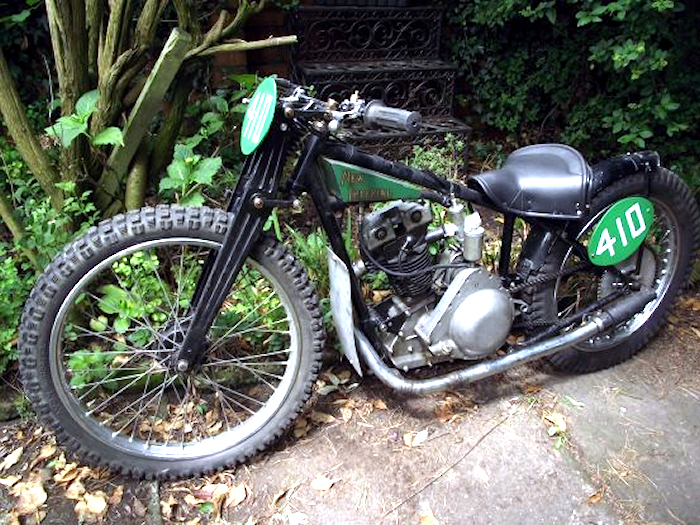
Jeremy Whittet says: Hello John, I emailed you a couple of years ago to say I had bought a New Imperial grasstrack bike, which came from a collection of four bikes. The intention was to let anyone interested to know where these bikes go. You put my bit somewhere near the bottom of bikes page one. I intended to convert it for road use. It is now registered and on the road, see attached pictures. The type 27 track carb has been replaced by an Amal 276, kickstart parts were eventually found and back brake sorted. There is no charging system, lights are LED from a battery. The tank is a pre 65 trials tank with a cut out for the air filter. Very difficult to find parts for these bikes. Sounds like you would imagine a 1930s grasstrack bike should and goes surprisingly well. See the 2 pics below.
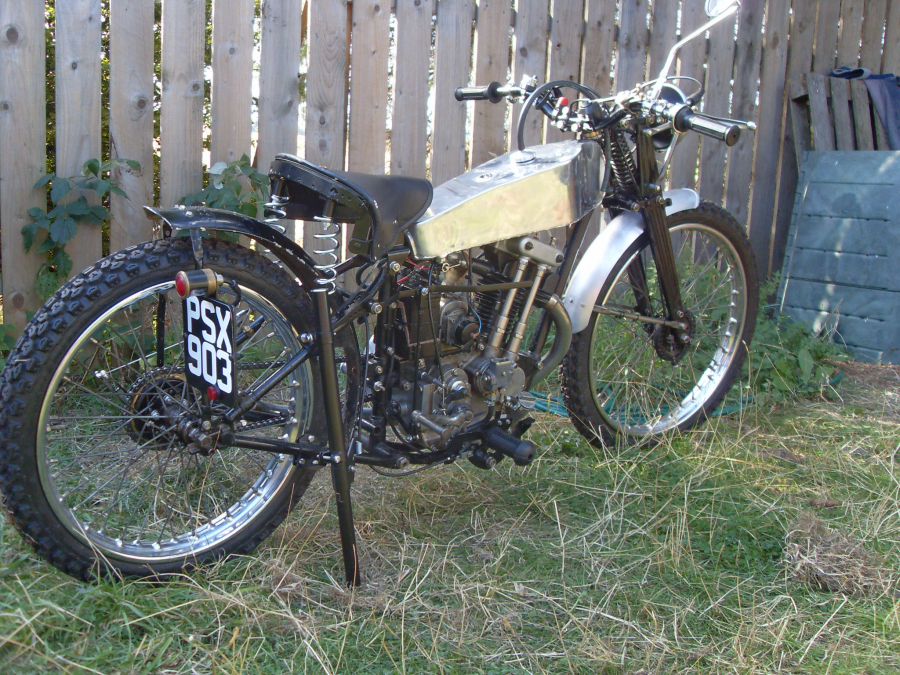
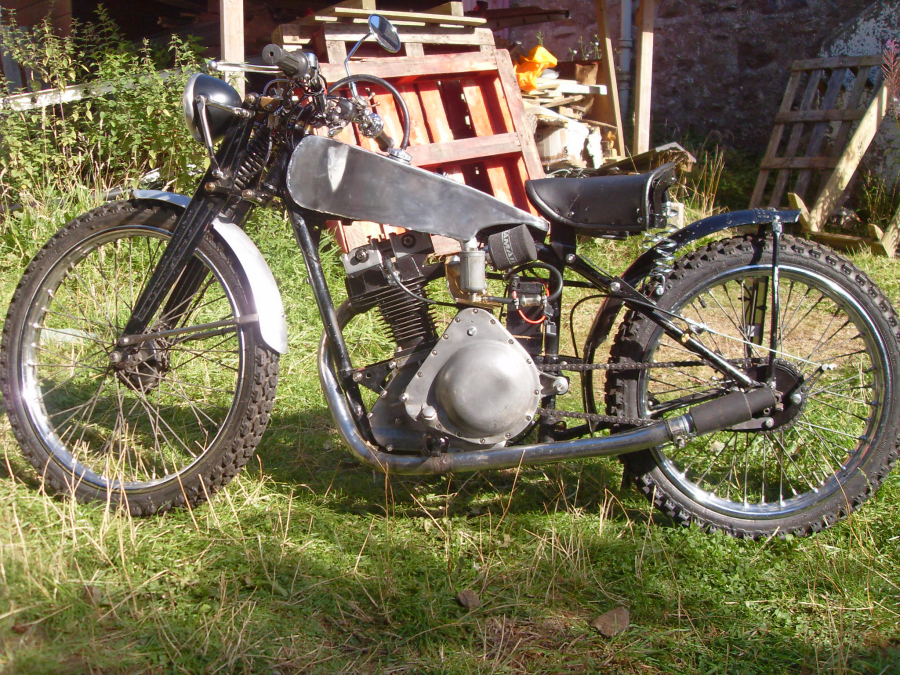
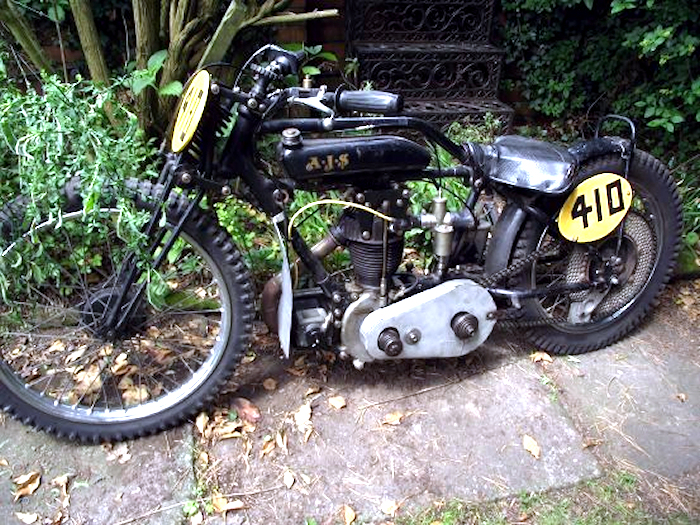
Appears to be based on an AJS M8 model. Raced by the late Leicester Grass Track racer Jack Brantom. The bike was known as "Wally Lamont Replica" and the bike was also referred to as "Killer 3". It was later raced by Jack's son. It featured in an article in Jan 1988 Classic Motorcycle magazine. It has not run for some time so will need some recommissioning or restoring. It has potential to revert back to desirable pre-war model M8.
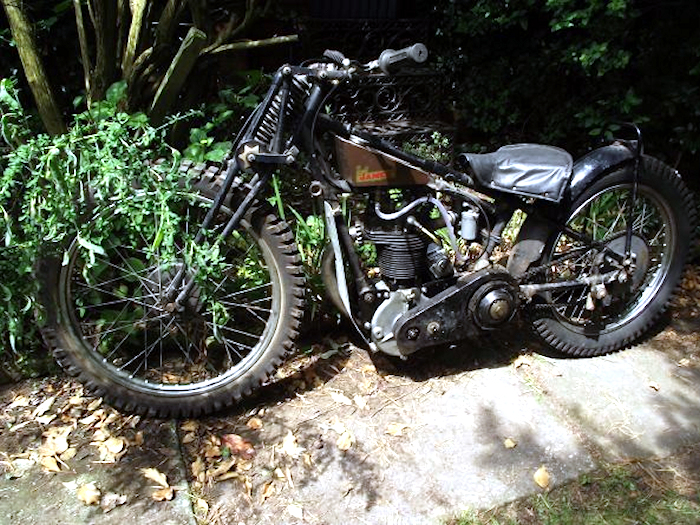
Believed to have been built from a 350cc B4 Super Sports model. It has not run for some time so will need either recommissioning or restoring but has the potential to revert back to the rare B4 Super Sport model. Motorcycle Grasstrack is a form of motorcycle racing which typically, in its current form, takes place on a flat track consisting of two straights and two bends usually constructed in a field. It is one of the oldest types of motorcycle sports in the UK with the first meetings taking place in the 1920s. In the United Kingdom, kidney-shaped circuits were sometimes used to include a right hand bend, and undulating hillsides were also used to increase the challenge for riders. The events traditionally occurred after haymaking and before harvesting season on newly-cut fields. Postwar grasstrack circuits included "permanent" venues such as Brands Hatch and Mallory Park which were not simple oval shapes, although solo motorcycle races were run in an anti-clockwise direction. Later, these were converted into tarmac circuits with races using the more common clockwise direction associated with modern road racing.
The main
reason I'm writing is that there is a picture of the New Imperial on
your website, Speedway Bikes, Part 6, Brian Winch's pictures from
Chalfont St Giles Hillclimb. Looks like the 80's going by the cars
in the background. It has No 411 on it rather than 410 on the
auction picture but definitely the same bike. Also in the picture is
the 500 AJS which sold at the auction. There is another picture of
it by itself two pictures up on your site.
Other issues I'm having to look at on the New Imperial are
- The carb is a needleless dirt track type, have got a different one to use
- First gear cog has been removed, only second and top are there. Very difficult to get parts, going to have to see how it goes. Was originally three speed hand change.
- No kickstart or mechanism, will have to push it.
- No rear brake drum, managed to get an unmachined casting which can be made to fit.
- Compression ratio, probably high due to domed piston. Also didn't run on petrol, main jet was 550.
Harley Peashooter
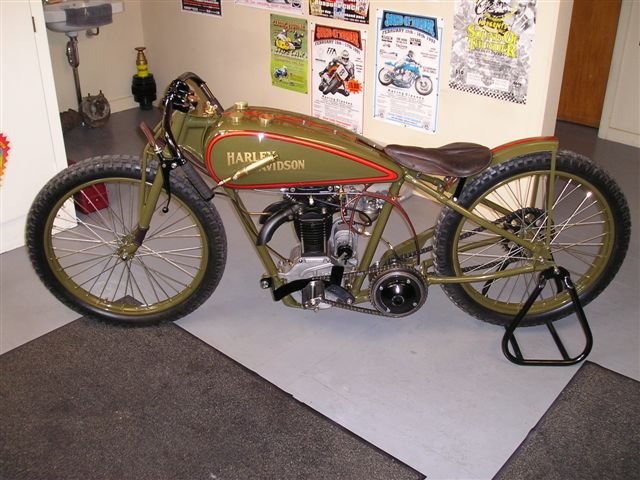
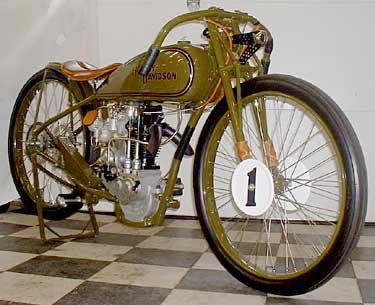
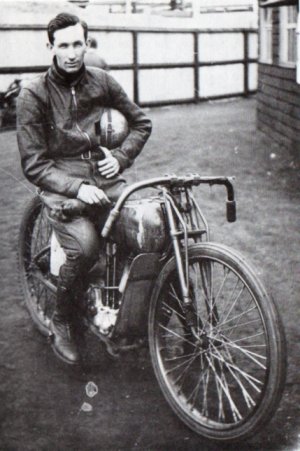
Frank Arthur (above right) astride his Harley Peashooter. The bikes were 350cc or 500cc. The Peashooter was a mid 1920s winner until the Douglas & Rudge came along.
Late 1920s
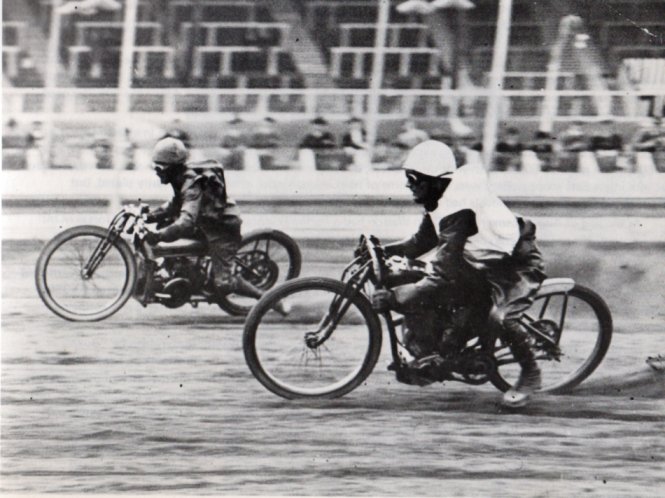
A Harley Peashooter inside battles it out with a Douglas flat twin
Old Bike Pics
From Tony Webb
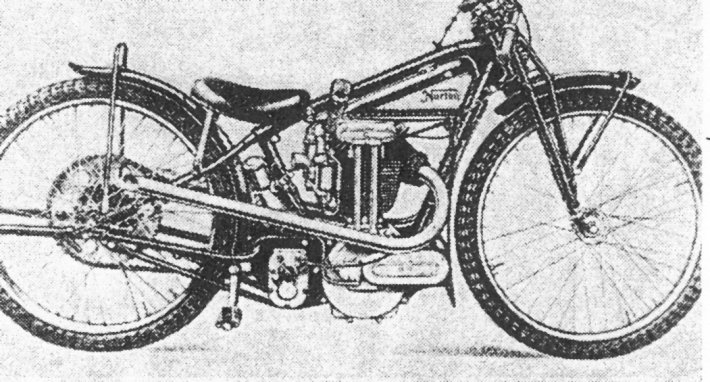
JAP Engine
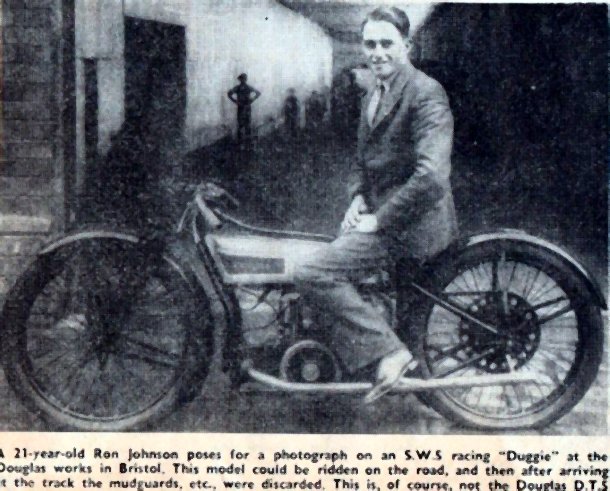
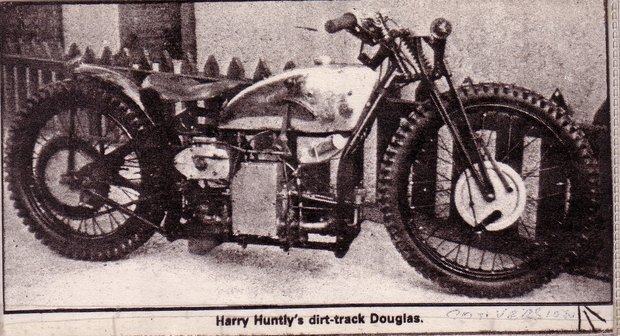
This bike was assembled from a "box of bits" by Harry Huntly. His son Ian, emailed this: -
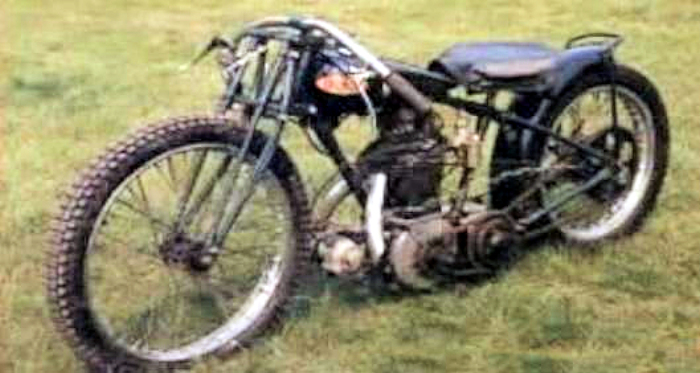
Above:
a BSA 500cc
Pat Jeal has been in touch with the following info and a couple of photographs: - I've attached a couple of pictures you may like.
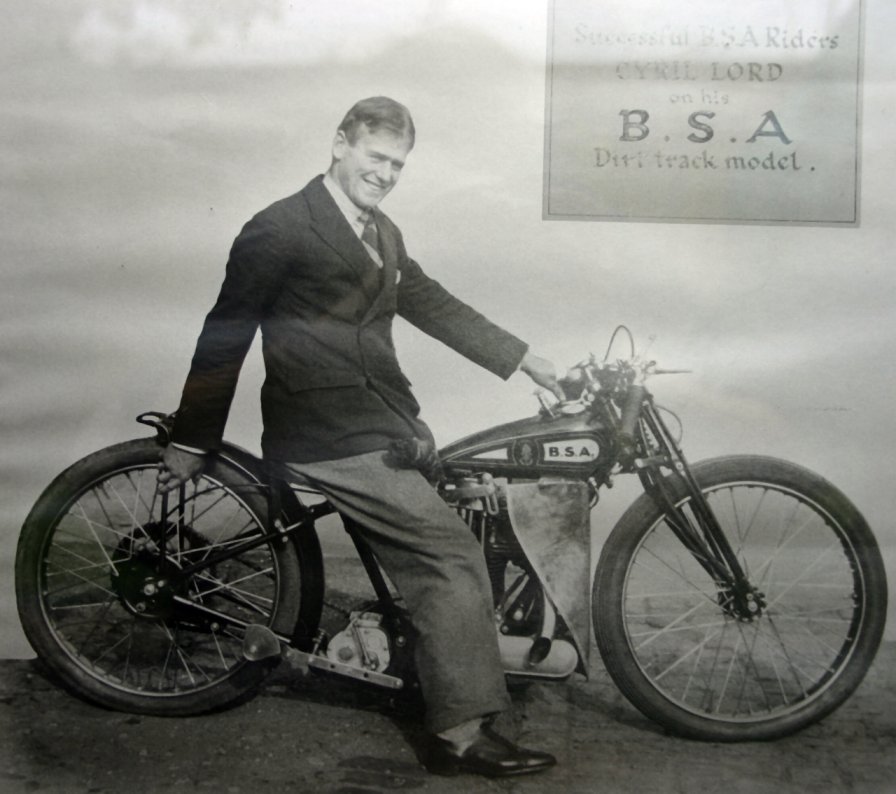
Pat
Jeal says:
I suspect the
BSA photo on your site is of this following restored bike, which was ridden by Cyril Lord and later owned by Noel Somerfield.
The photo is of it in grass trim at the 1968 High Beech reunion
but I know it later had a brakeless 21" front wheel refitted.
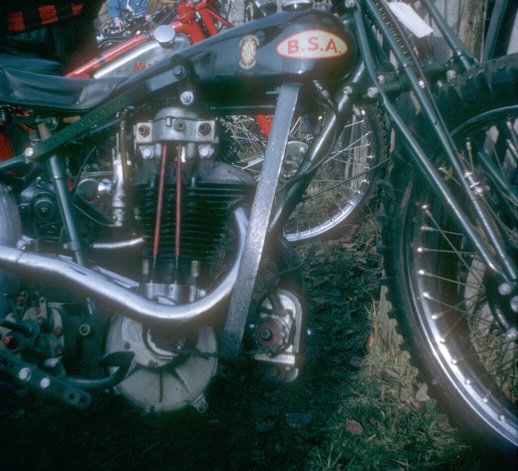
1929 BSA Road Version (For Comparison)
1930 BSA S29- S19
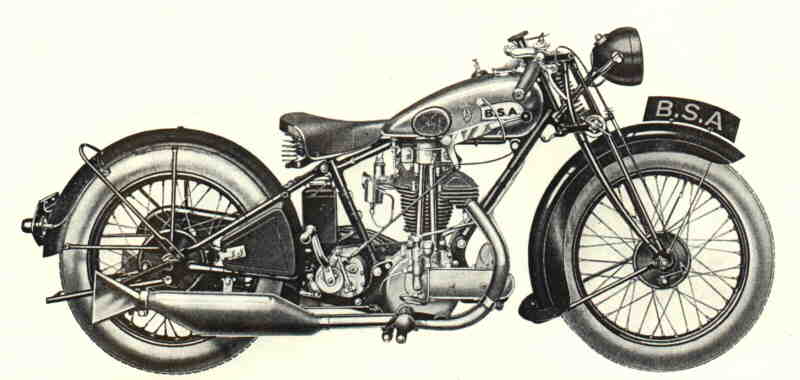
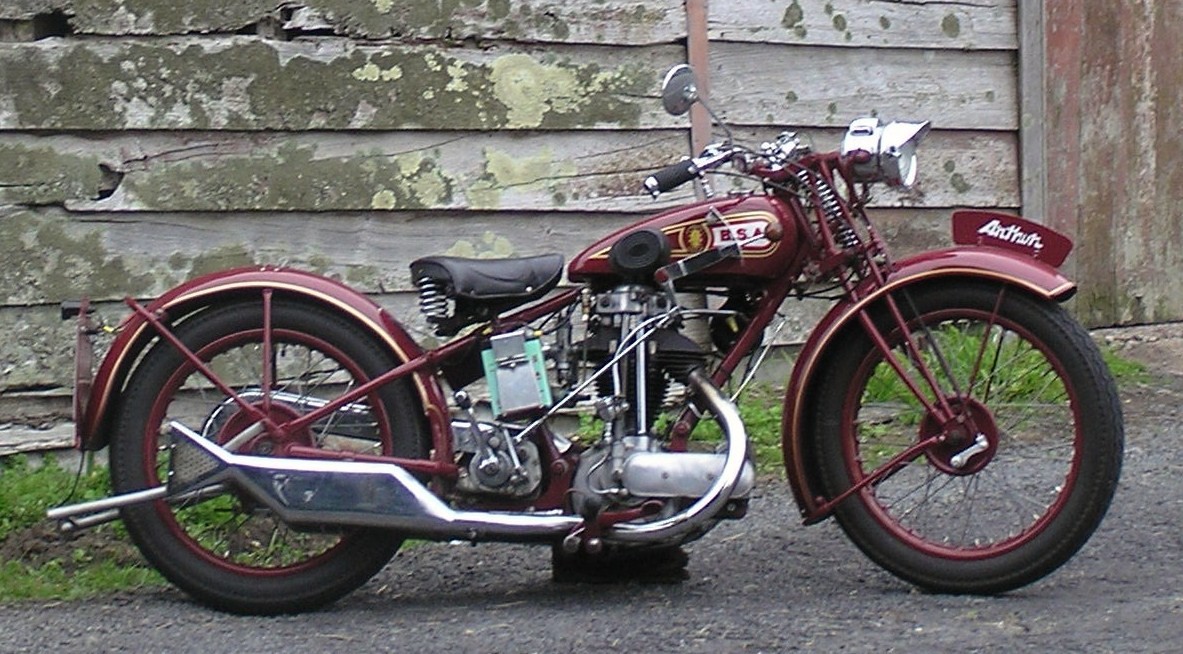
Courtesy of Les Elmer
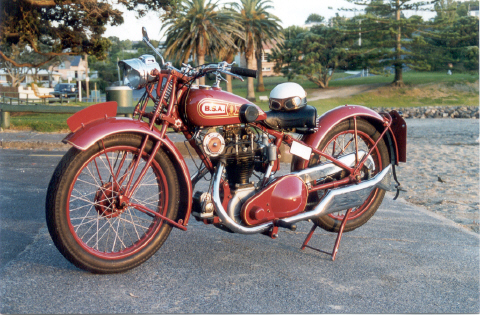
The 1929 BSA roadster appears to be the machine BSA used as the basis for their speedway machine
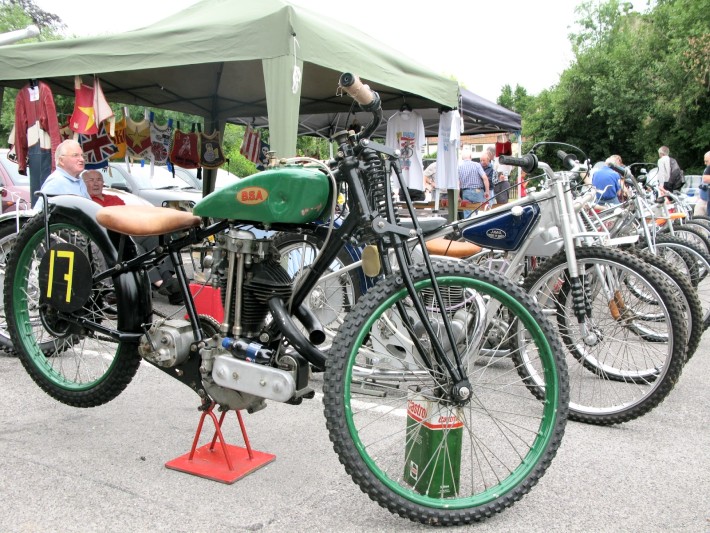
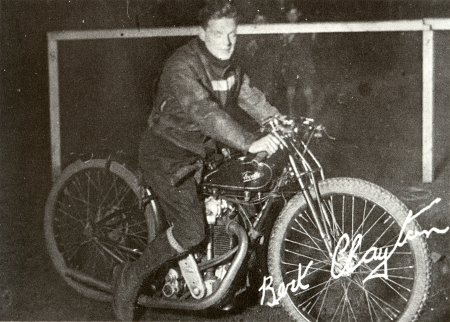

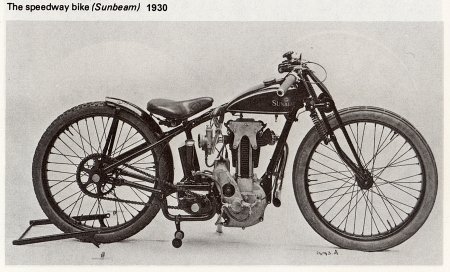
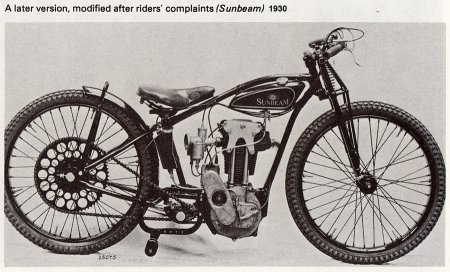

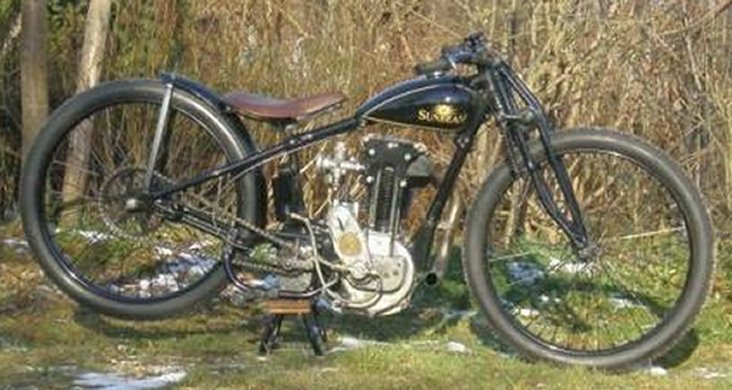
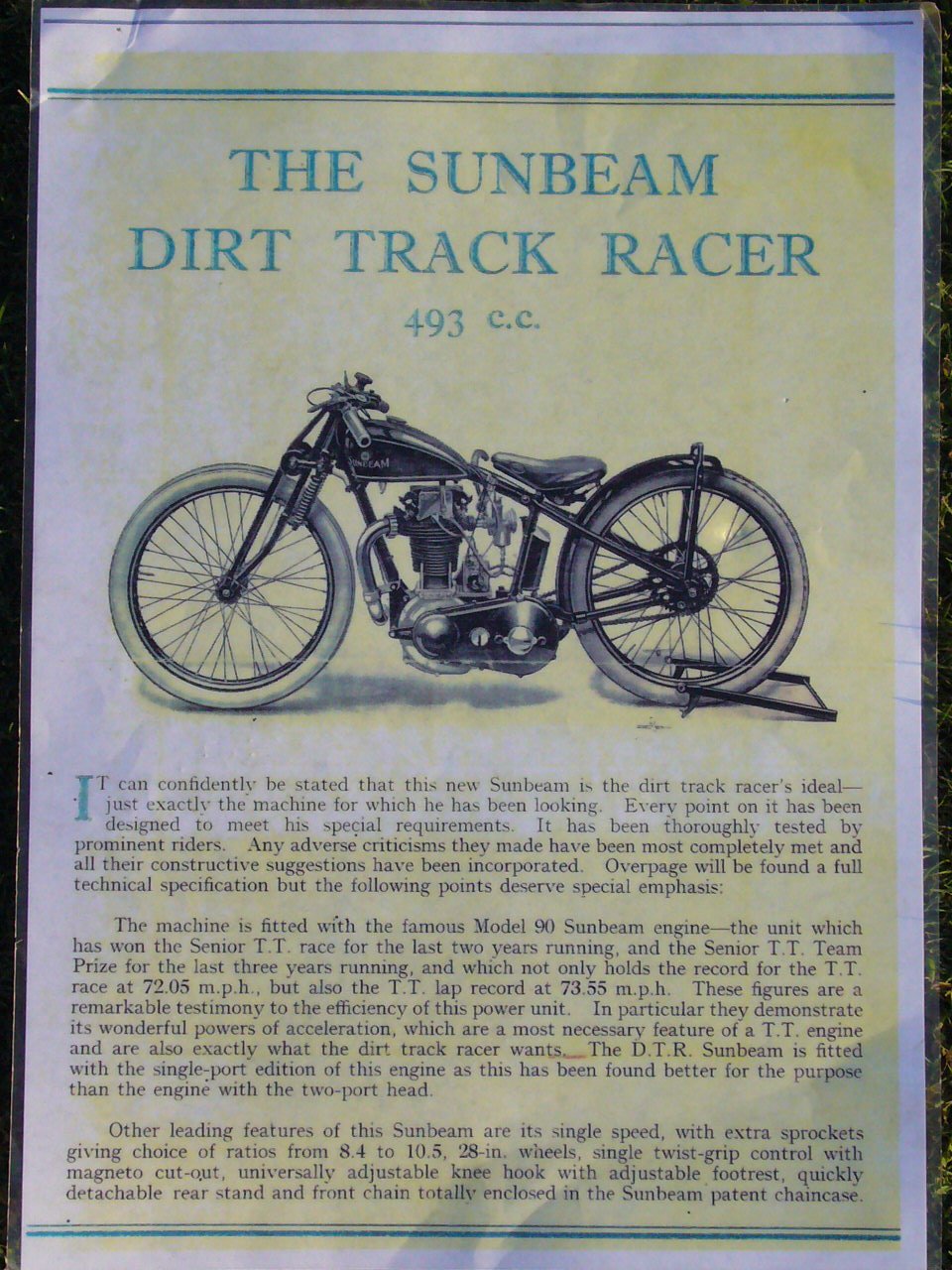
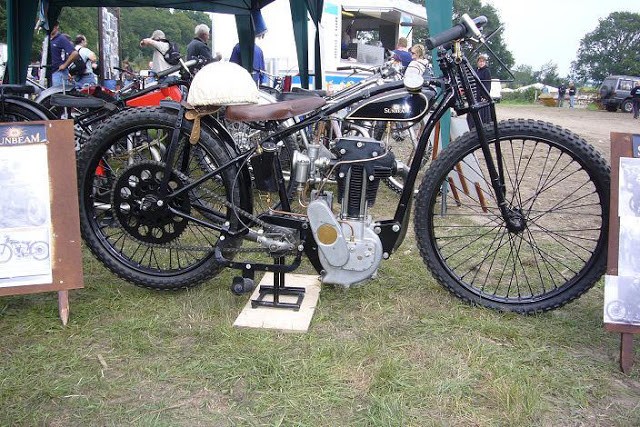
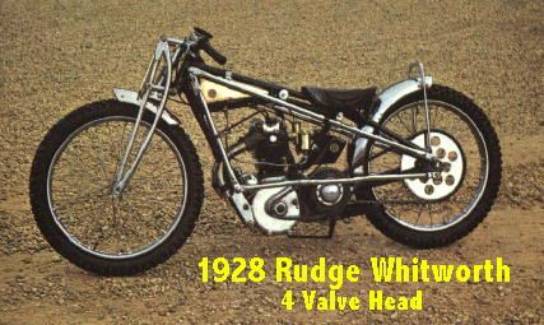
Above: The Rudge 500.This example looks very potent even by modern bike standards. (Four valve technology is not modern ) I bet this machine raced flat out would frighten the life out of a lot of modern bikers!
JAP In A Rudge Frame
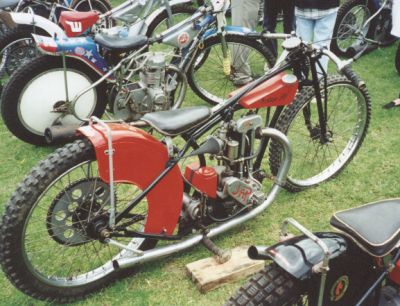
1920s Or 1930's
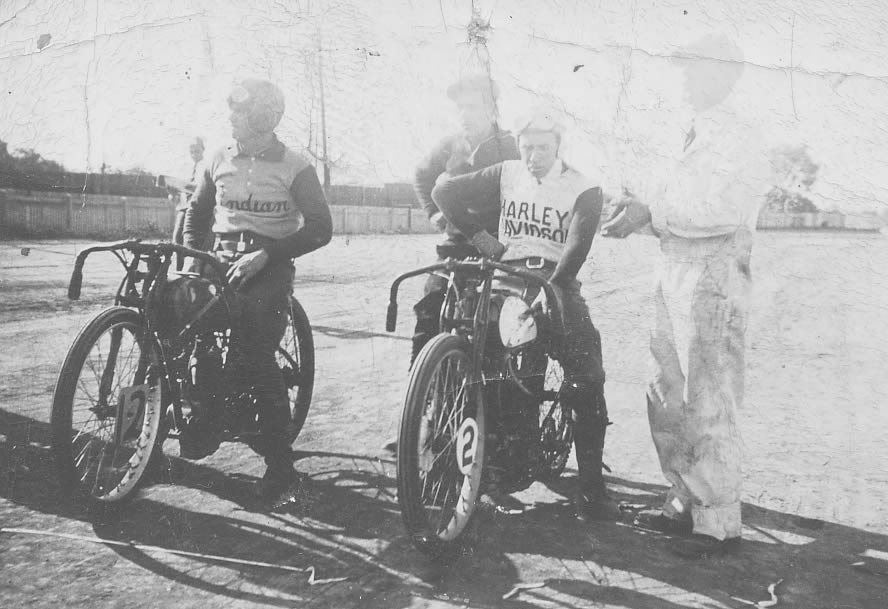
American Riders 1930's at the Richmond Raceway, (Picture courtesy of Carrick Watson) US riders had been racing around their dirt tracks for a number of years before we got underway in 1928. These riders are obviously mounted on an Indian (left) and a Harley Davidson. The Indian became a popular mount for Wall of Death riders. They don't appear to be wearing much body protection. I assume therefore that they are simply posing for pictures but who knows maybe they raced in their long johns in 1930's, Richmond USA!
The long wheel base Douglas was the first choice of the "leg trailing winners" with the shorter wheel base Rudge giving the foot forward riders the edge. Then came the JAP in 1931 and the older bikes gradually gave way until all riders were mounted on the mighty JAP.
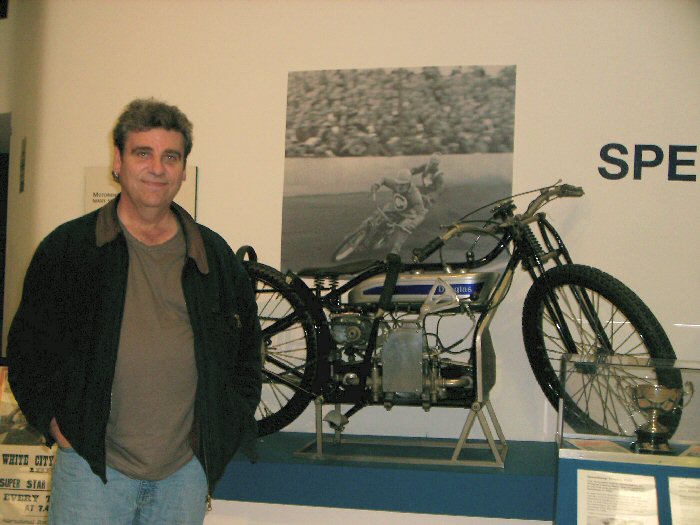
The Website owner, John Skinner, at the Glasgow Transport Museum. The Bike is a 1929 Douglas D.T. The picture on the wall shows an Glasgow rider leading a Newcastle Diamond. The Glasgow museum is well worth a trip, whether you pay the speedway a visit or not.
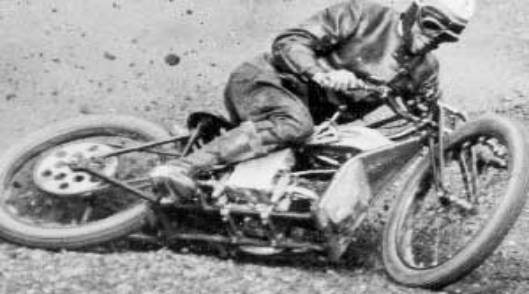
A 500cc Douglas Dirt Bike.
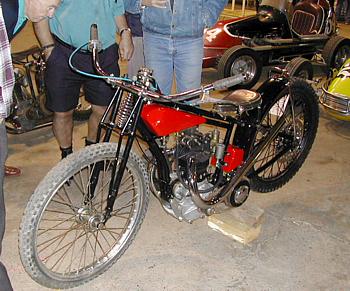
A Speedway Rudge
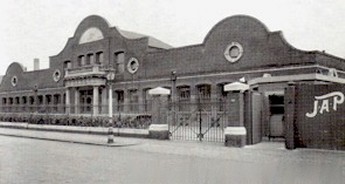
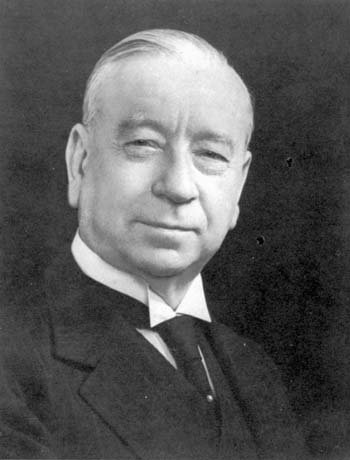
John Alfred Prestwich. A very clever man who invented a number of things including his JAP engines used in speedway
Dawn Of The JAP 1931
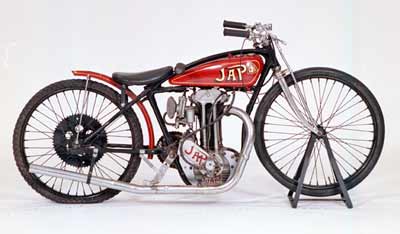
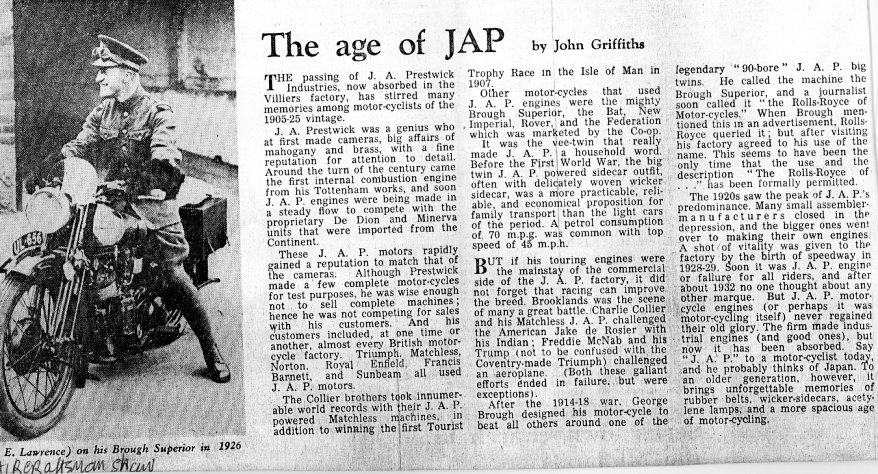
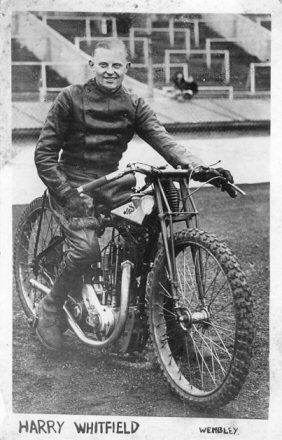
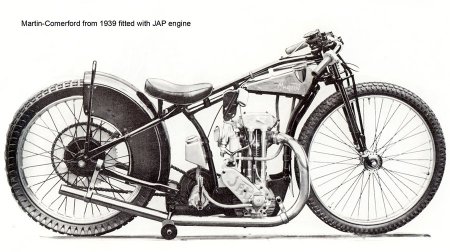
Bikes Page 2 Bikes Page 3 Bikes Page 4 Bikes Page 5 Bikes Page 6 Bikes Page 7